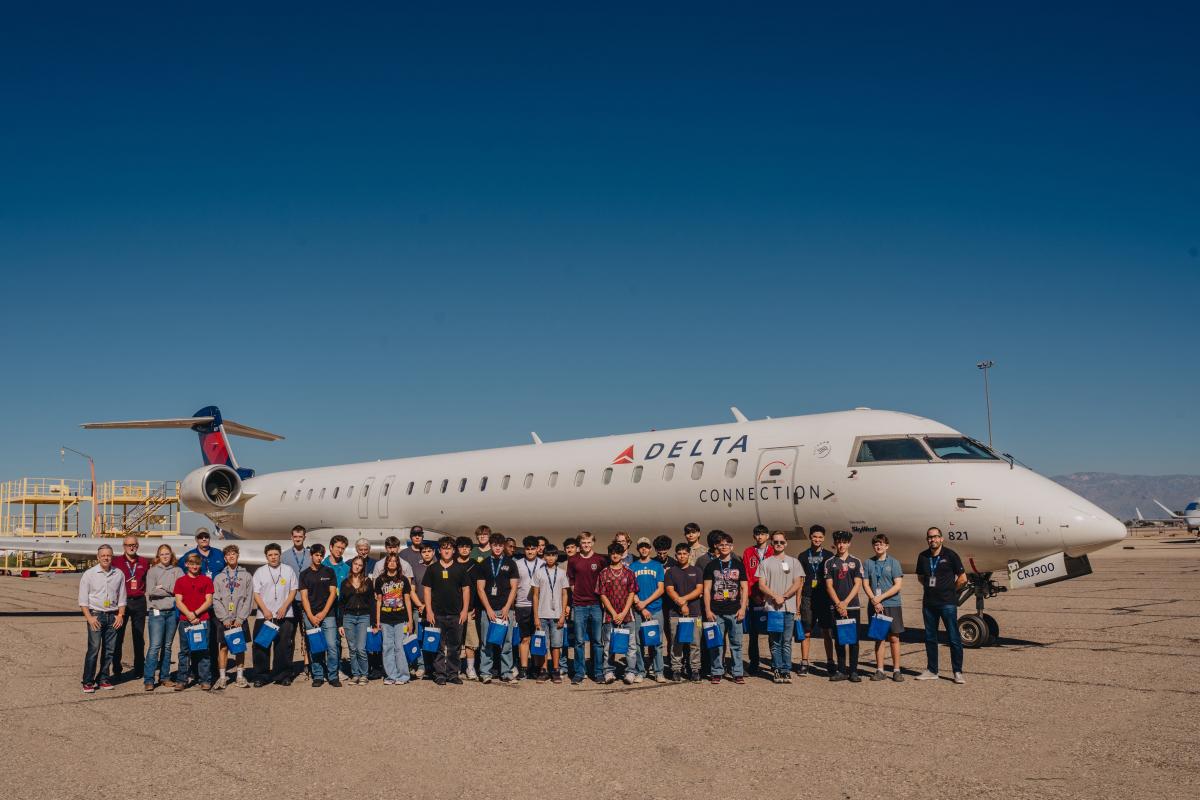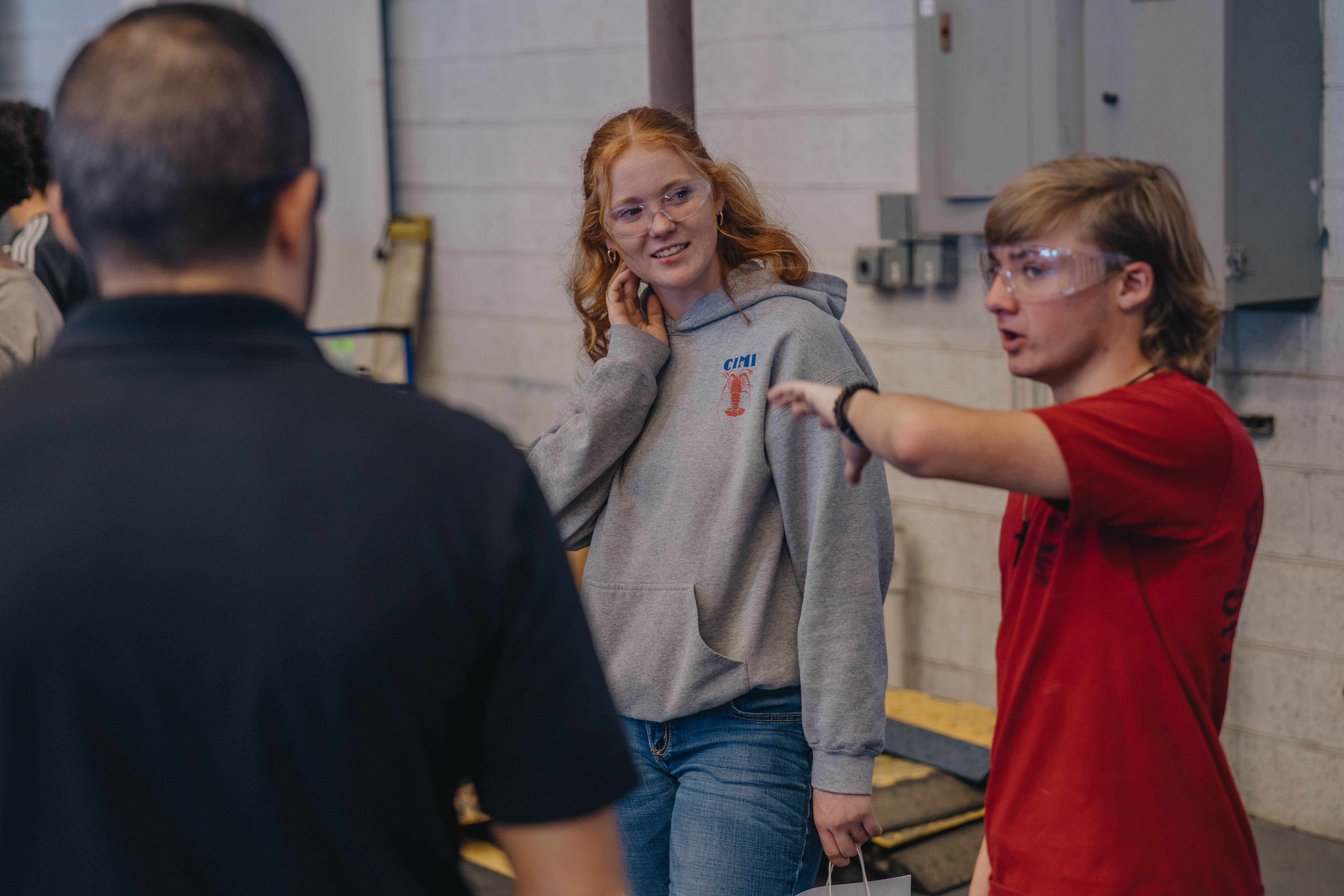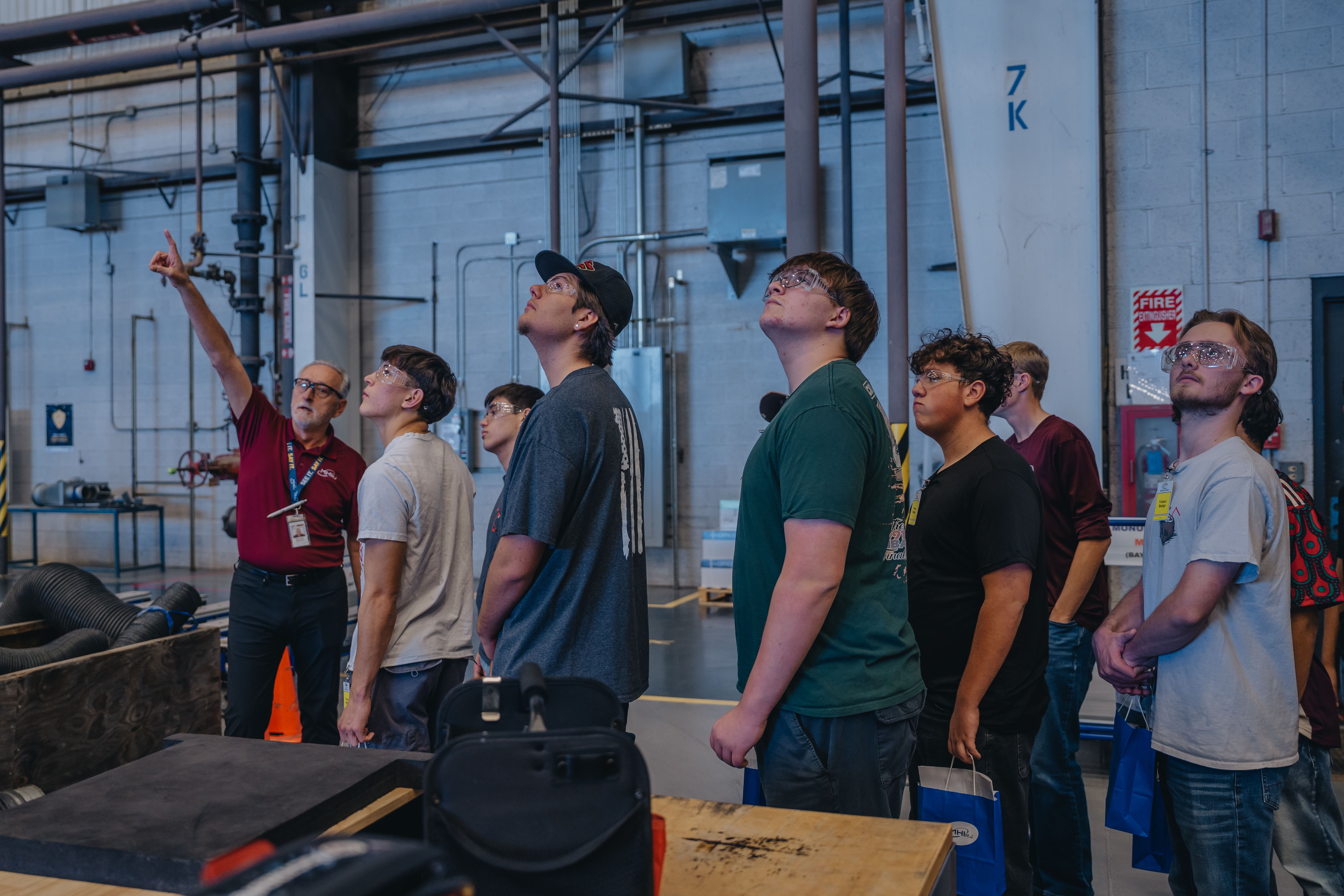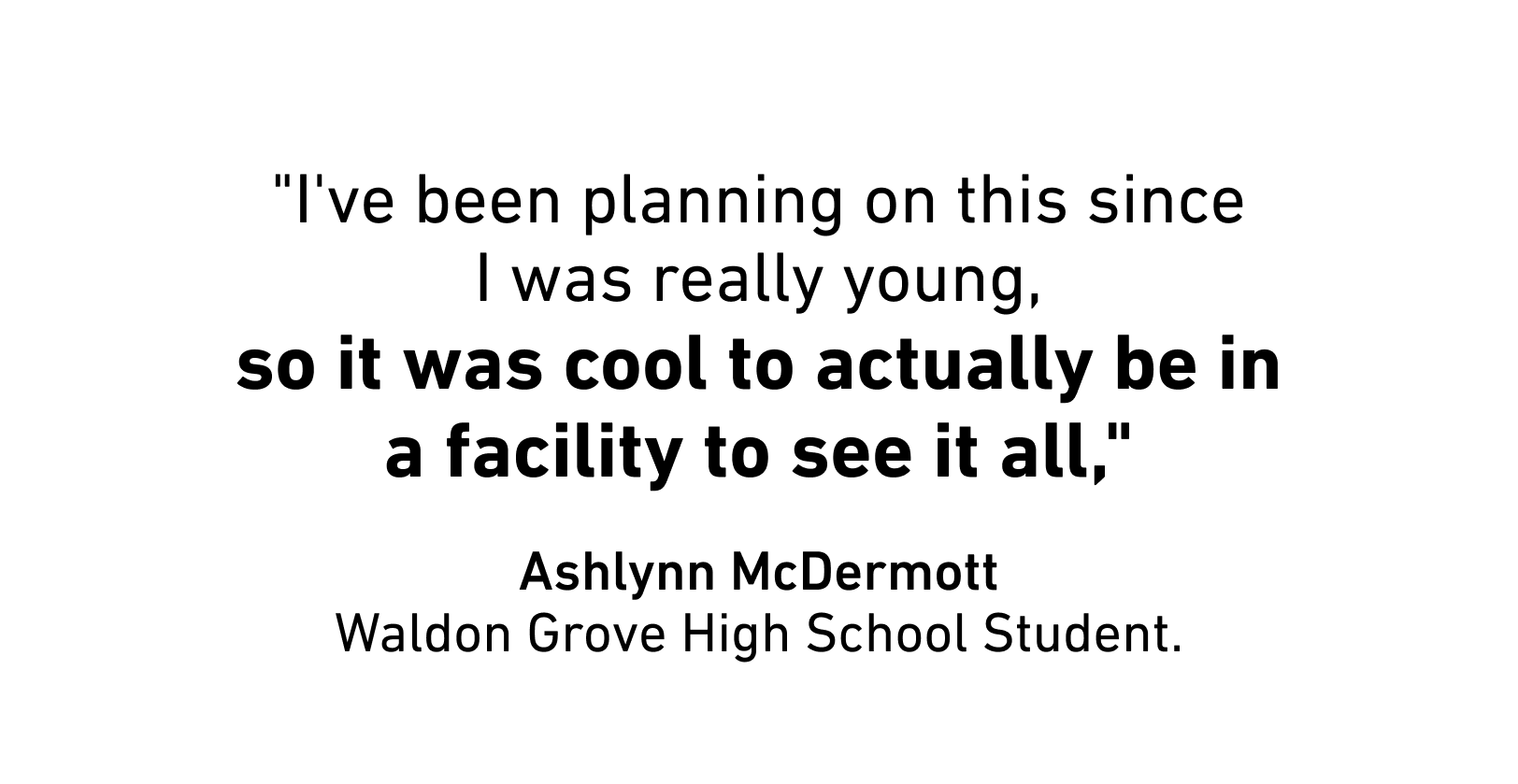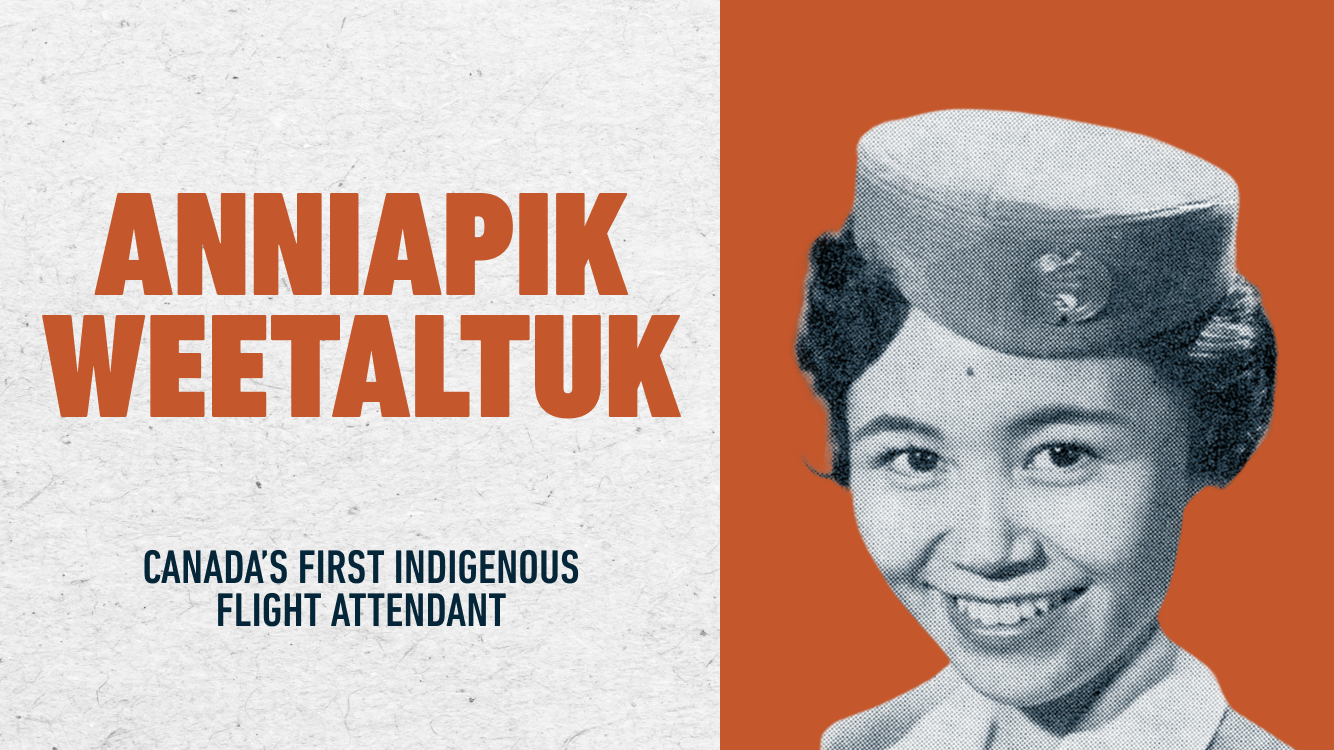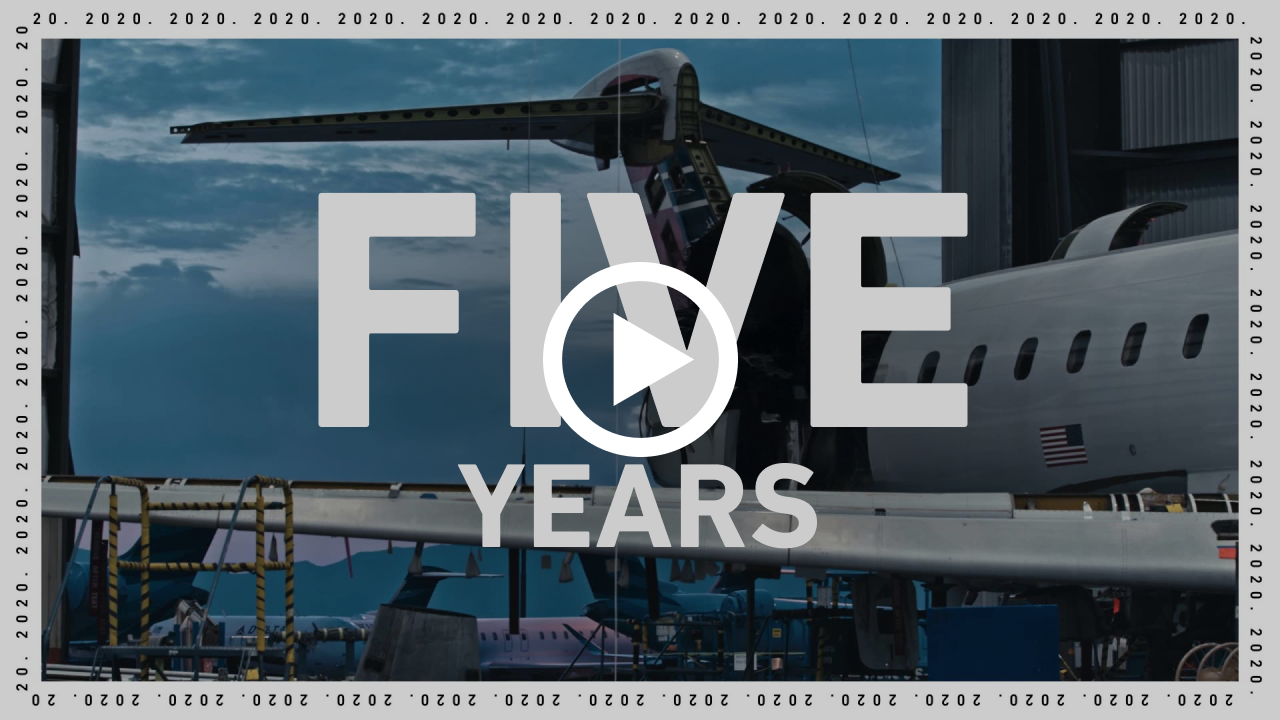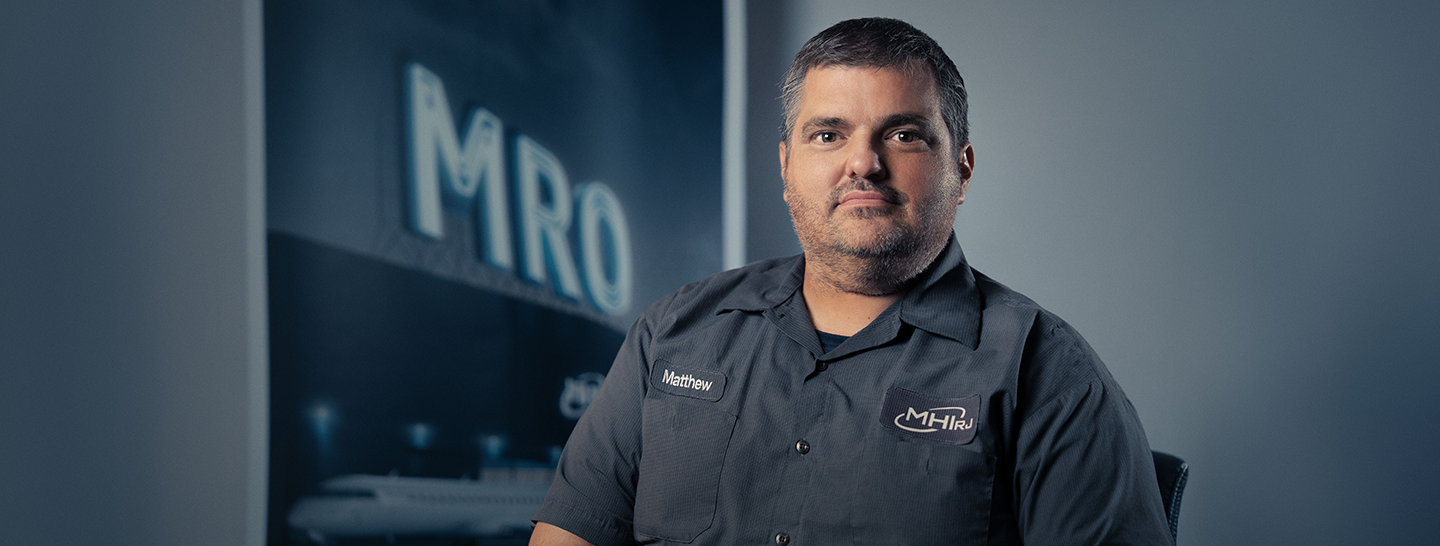-
REGIONAL TURBOPROPS IN NORTH AMERICA: A LEGACY IN DECLINE

For decades, regional air travel across North America was dominated by propeller-driven aircraft. Turboprops like the SAAB 340 and Beechcraft 1900 handled short routes, connecting small towns to bigger cities.
Passengers took ATRs and Dash-8s for flights between secondary cities and major hubs, but had to board through tiny terminals, often walking across the tarmac. It wasn’t ideal, but it served its purpose. Turboprops were economical, could land on short runways, and kept regional networks alive.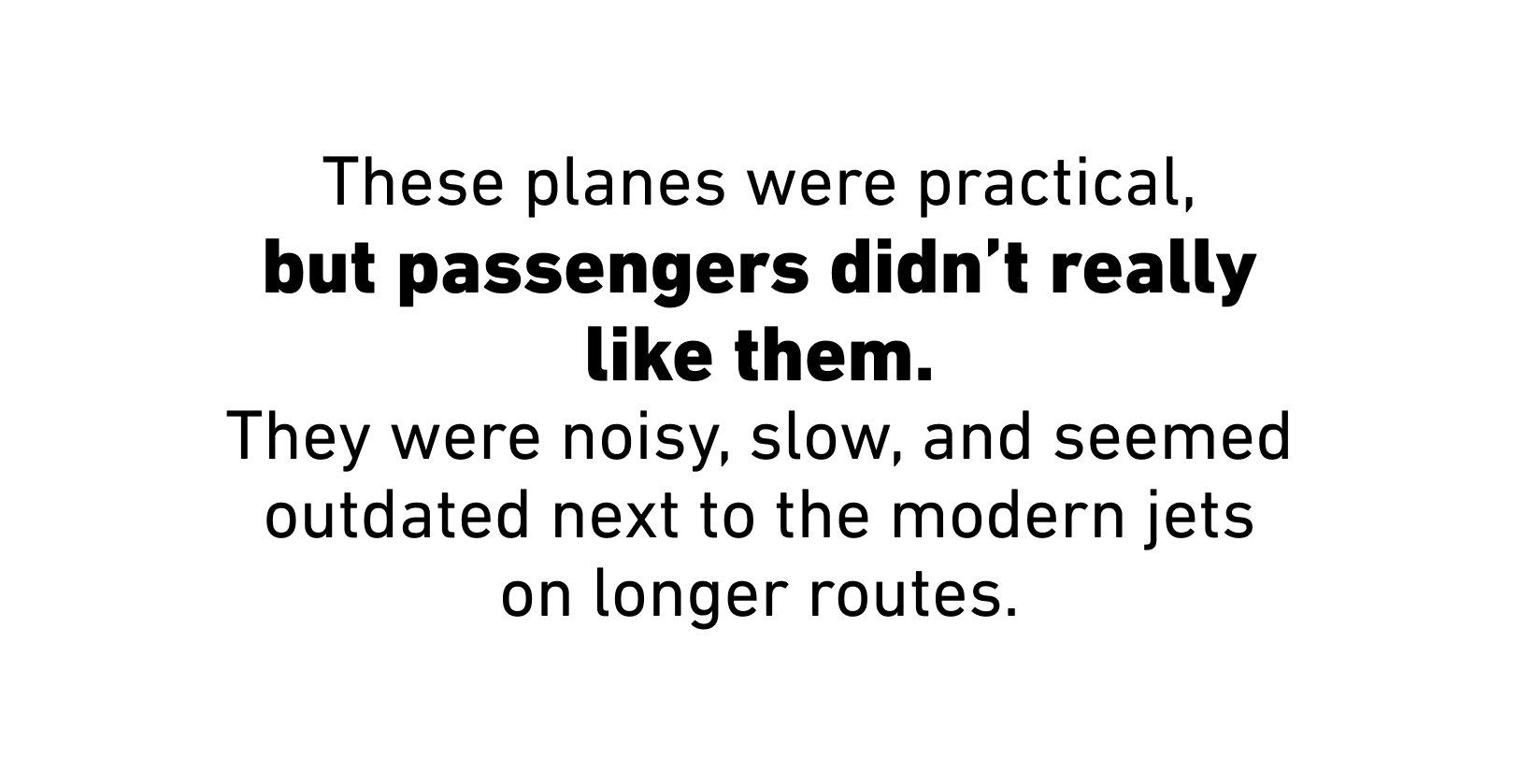
These planes were practical, but passengers didn’t really like them. They were noisy, slow, and seemed outdated next to the modern jets on longer routes. Airlines faced a dilemma. They needed something faster, quieter, and more comfortable yet small enough to serve thin routes economically. But the answer didn’t exist just yet.
THE RISE OF THE REGIONAL JET
By the mid-1990s, regional jets like the Canadair Regional Jet (CRJ) and Embraer ERJ families began serving regional airports, promising greater speed, comfort, and the prestige of flying aboard a real jet.
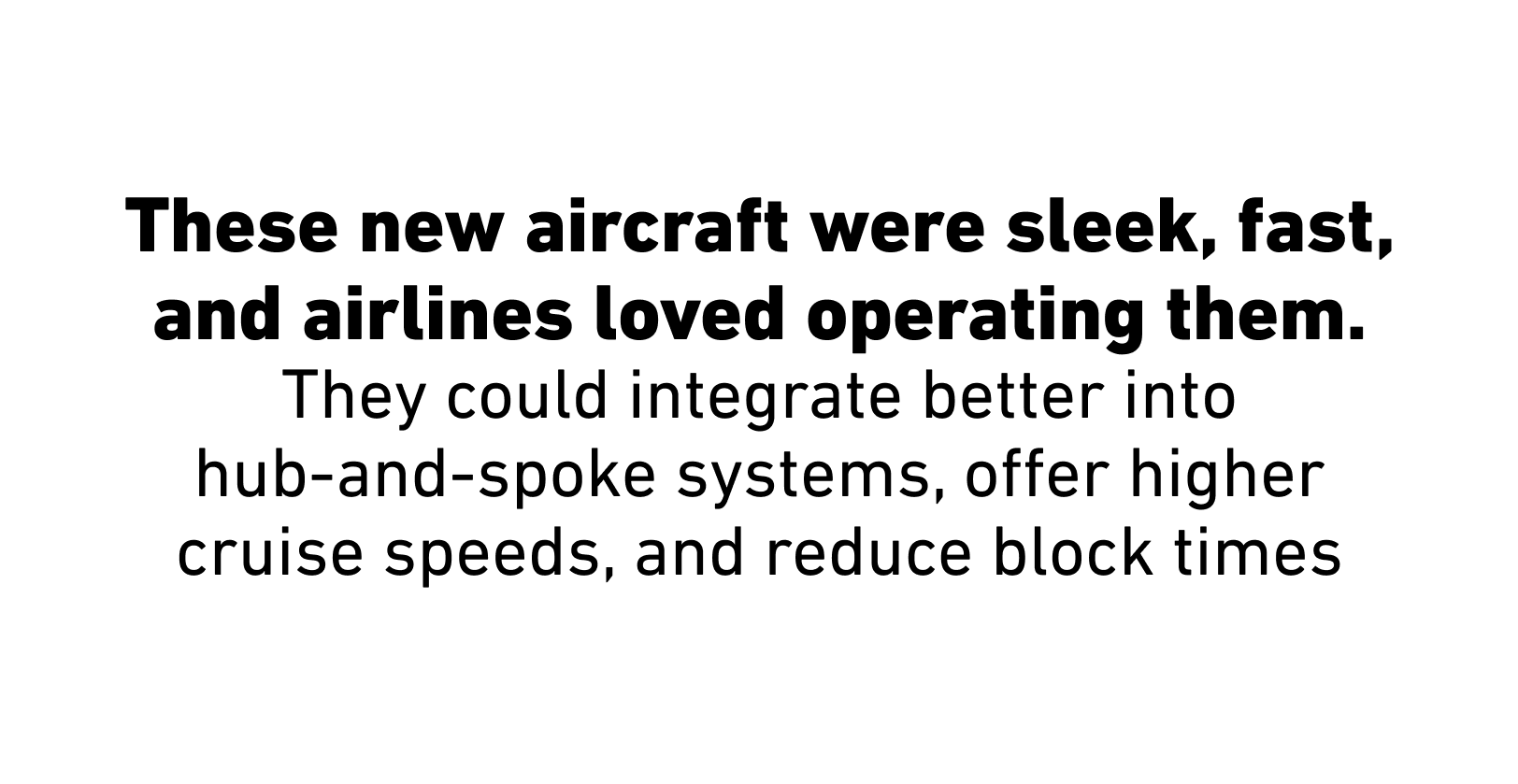
These new aircraft were sleek, fast, and airlines loved operating them. They could integrate better into hub-and-spoke systems, offer higher cruise speeds and reduce block times. Regional jets were also interchangeable with other single-aisle aircraft, without requiring adjustments to the schedule. Passengers appreciated the quieter cabins and the absence of propeller vibration. Eventually, their expectations shifted permanently, and comfort took precedence over marginal savings.
Suddenly, turboprops seemed outdated and the market began to tilt. The decline wasn’t overnight; it was more like a slow erosion. Airlines began phasing out their SAAB and Beechcraft fleets first, followed by gradual reductions in ATR and Dash-8 operations.
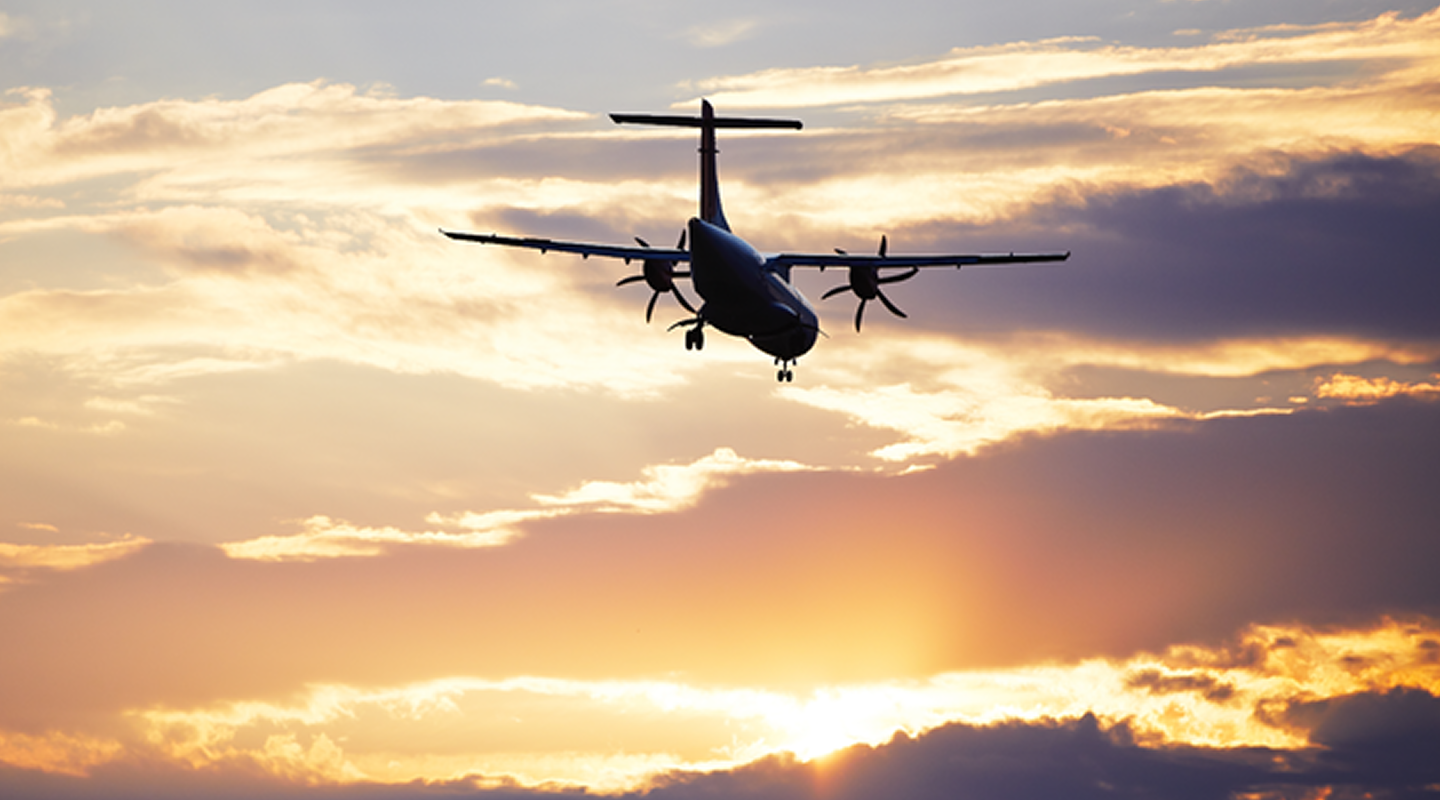
The most recent introduction of Regional Turboprops into the U.S. was Silver Airways in 2019. Silver was upgrading from older 34-seat SAAB 340s to larger ATRs. At the time the airline boasted that aircraft with better economics and efficiency would be transformational for Silver. ATR indicated that the introduction of the new aircraft would lead to what they expected to be a new wave of eco-responsible and passenger- friendly regional travel, and the return of the ATRs in the U.S. However, only five years later the ATRs were gone, and Silver was out of business.
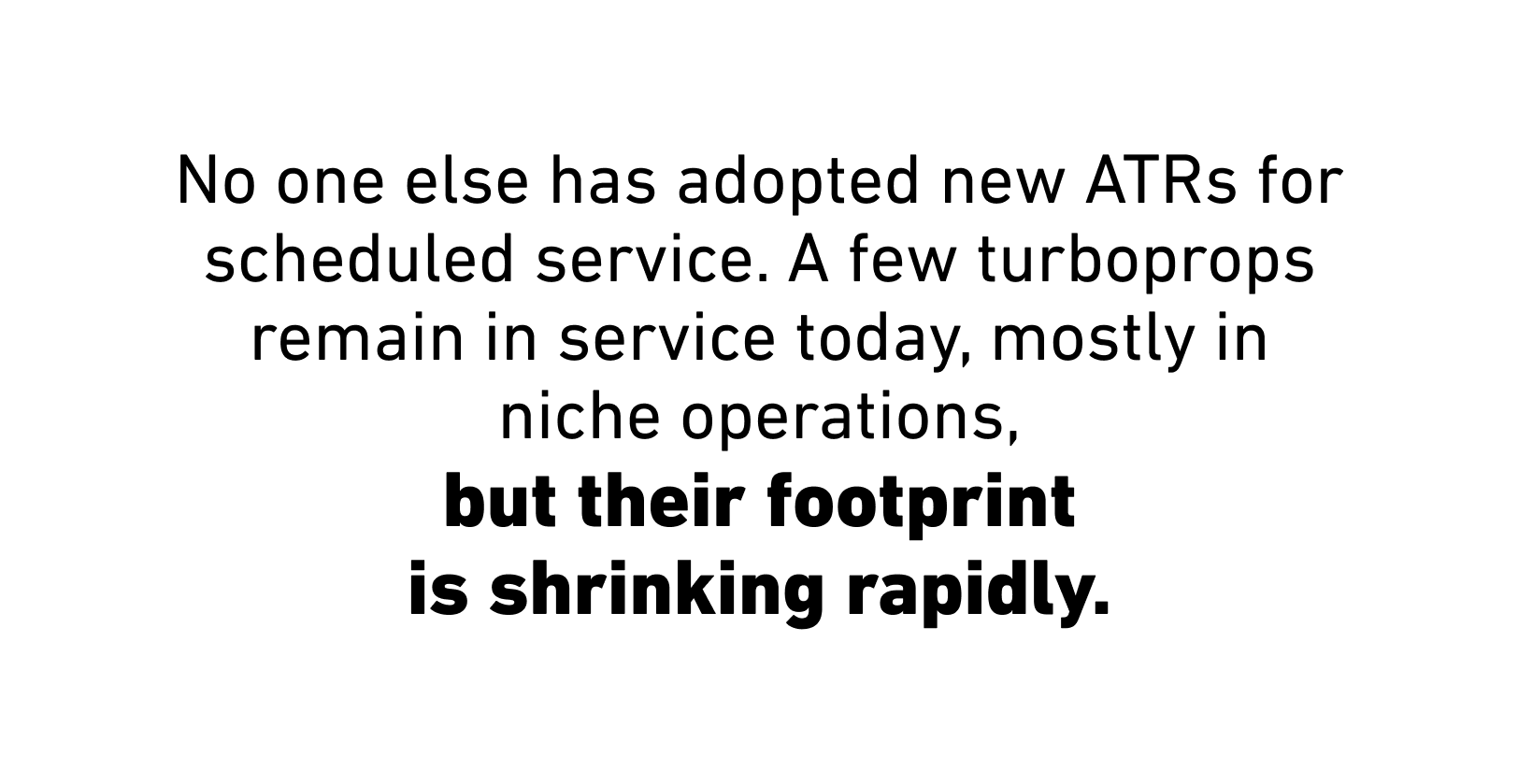
No one else has adopted new ATRs for scheduled service. A few turboprops remain in service today, mostly in niche operations, but their footprint is shrinking rapidly.
WHY CONVENTIONAL TURBOPROPS WON’T RETURN
While sustainability discussions occasionally revive interest in turboprops, the reality is that infrastructure and networks have changed, and many small routes were abandoned to other forms of travel. Scope clauses now dictate the market requirements. Smaller turboprops are unlikely to return unless new aircraft with better economics are developed and chronic shortages of maintenance technicians and pilots are resolved.
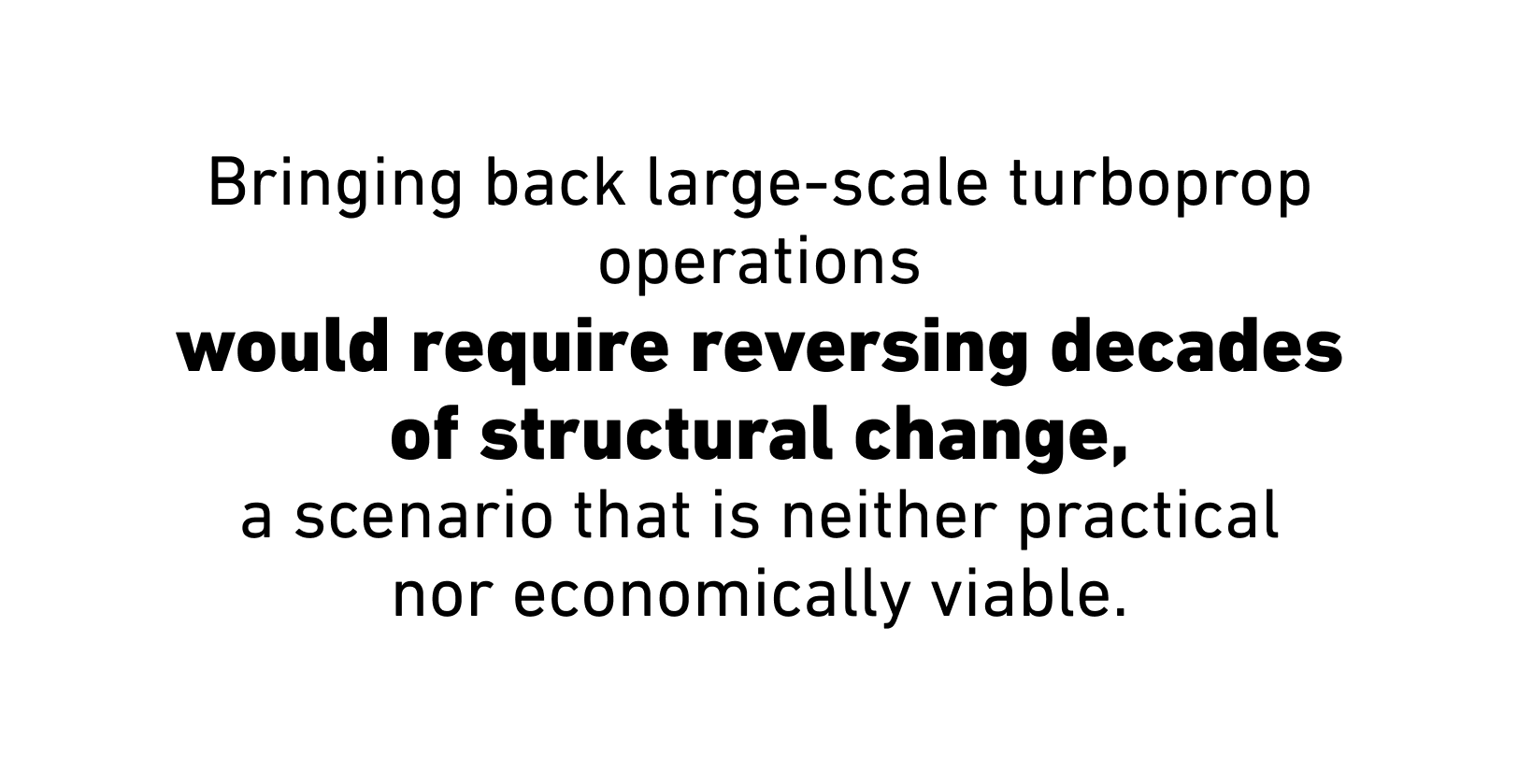
Bringing back large-scale turboprop operations would require reversing decades of structural change, a scenario that is neither practical nor economically viable.
This reality was further reinforced by the announcement earlier this fall from Embraer’s CEO, confirming the cancellation of their turboprop program, signaling a strategic pivot toward electric and hybrid propulsion concepts rather than conventional turboprops.
LEGACY AND FUTURE
Turboprops didn’t fail; they evolved out of necessity. While they connected communities and made regional flying affordable, their decline reflects a broader truth, that aviation is continually striving for speed, comfort, and efficiency.
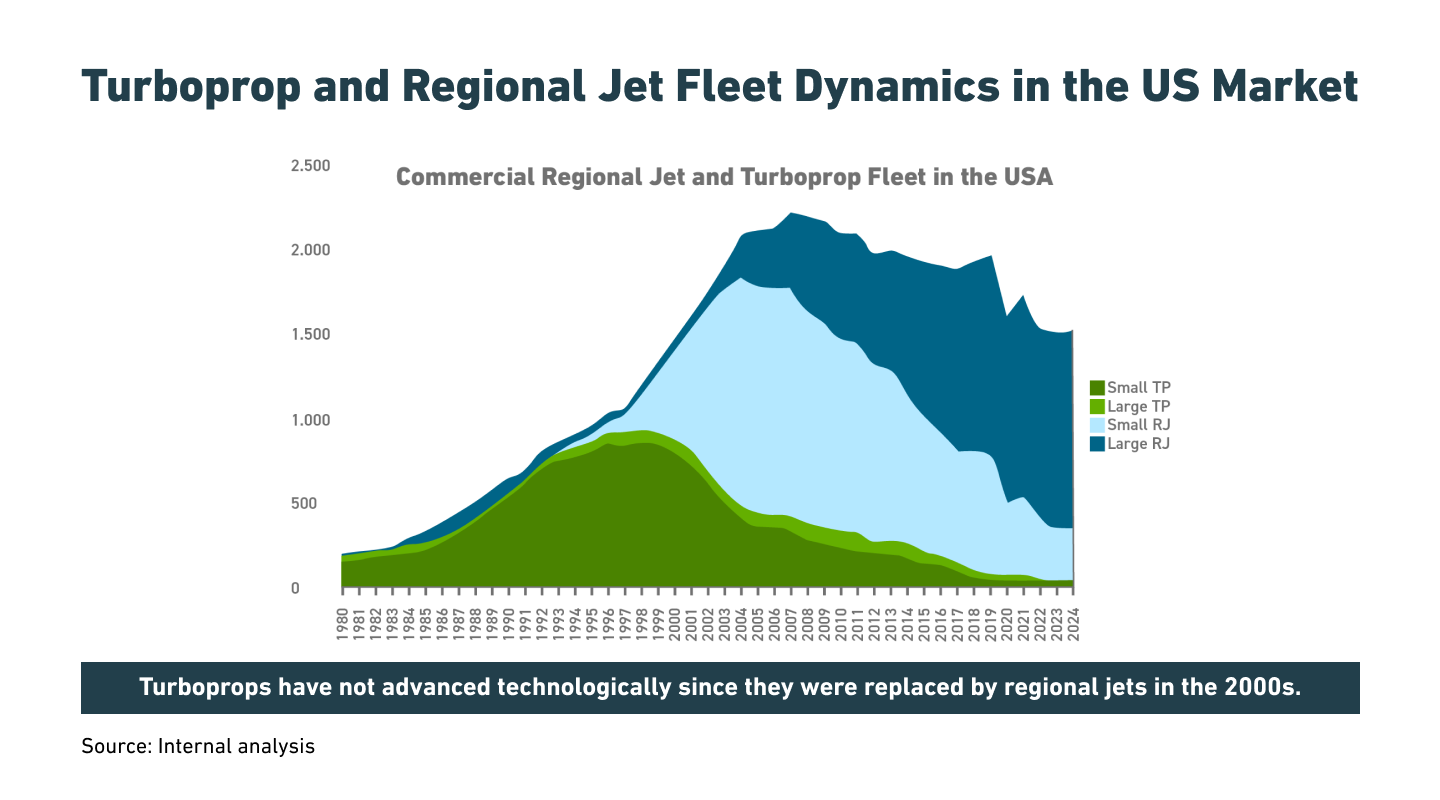
And as sustainability reshapes the industry, the spirit of the turboprop may return, not with propellers, but with quiet, electric motors powering the next generation of short-haul aircraft.
While these technologies are still in development, they align with global decarbonization goals and passenger expectations for modern, eco-friendly travel. Unlike turboprops, electric and hybrid aircraft represent a forward-looking solution rather than a nostalgic return to the past.
3 MIN- Log in to post comments
REGIONAL TURBOPROPS IN NORTH AMERICA: A LEGACY IN DECLINE

For decades, regional air travel across North America was dominated by propeller-driven aircraft. Turboprops like the SAAB 340 and Beechcraft 1900 handled short routes, connecting small towns to bigger cities.
Passengers took ATRs and Dash-8s for flights between secondary cities and major hubs, but had to board through tiny terminals, often walking across the tarmac. It wasn’t ideal, but it served its purpose. Turboprops were economical, could land on short runways, and kept regional networks alive.
These planes were practical, but passengers didn’t really like them. They were noisy, slow, and seemed outdated next to the modern jets on longer routes. Airlines faced a dilemma. They needed something faster, quieter, and more comfortable yet small enough to serve thin routes economically. But the answer didn’t exist just yet.
THE RISE OF THE REGIONAL JET
By the mid-1990s, regional jets like the Canadair Regional Jet (CRJ) and Embraer ERJ families began serving regional airports, promising greater speed, comfort, and the prestige of flying aboard a real jet.

These new aircraft were sleek, fast, and airlines loved operating them. They could integrate better into hub-and-spoke systems, offer higher cruise speeds and reduce block times. Regional jets were also interchangeable with other single-aisle aircraft, without requiring adjustments to the schedule. Passengers appreciated the quieter cabins and the absence of propeller vibration. Eventually, their expectations shifted permanently, and comfort took precedence over marginal savings.
Suddenly, turboprops seemed outdated and the market began to tilt. The decline wasn’t overnight; it was more like a slow erosion. Airlines began phasing out their SAAB and Beechcraft fleets first, followed by gradual reductions in ATR and Dash-8 operations.

The most recent introduction of Regional Turboprops into the U.S. was Silver Airways in 2019. Silver was upgrading from older 34-seat SAAB 340s to larger ATRs. At the time the airline boasted that aircraft with better economics and efficiency would be transformational for Silver. ATR indicated that the introduction of the new aircraft would lead to what they expected to be a new wave of eco-responsible and passenger- friendly regional travel, and the return of the ATRs in the U.S. However, only five years later the ATRs were gone, and Silver was out of business.

No one else has adopted new ATRs for scheduled service. A few turboprops remain in service today, mostly in niche operations, but their footprint is shrinking rapidly.
WHY CONVENTIONAL TURBOPROPS WON’T RETURN
While sustainability discussions occasionally revive interest in turboprops, the reality is that infrastructure and networks have changed, and many small routes were abandoned to other forms of travel. Scope clauses now dictate the market requirements. Smaller turboprops are unlikely to return unless new aircraft with better economics are developed and chronic shortages of maintenance technicians and pilots are resolved.

Bringing back large-scale turboprop operations would require reversing decades of structural change, a scenario that is neither practical nor economically viable.
This reality was further reinforced by the announcement earlier this fall from Embraer’s CEO, confirming the cancellation of their turboprop program, signaling a strategic pivot toward electric and hybrid propulsion concepts rather than conventional turboprops.
LEGACY AND FUTURE
Turboprops didn’t fail; they evolved out of necessity. While they connected communities and made regional flying affordable, their decline reflects a broader truth, that aviation is continually striving for speed, comfort, and efficiency.

And as sustainability reshapes the industry, the spirit of the turboprop may return, not with propellers, but with quiet, electric motors powering the next generation of short-haul aircraft.
While these technologies are still in development, they align with global decarbonization goals and passenger expectations for modern, eco-friendly travel. Unlike turboprops, electric and hybrid aircraft represent a forward-looking solution rather than a nostalgic return to the past.
3 MIN- Log in to post comments
-
ATR THINKS THAT TURBOPROPS CAN REPLACE 50-SEATER JETS: HERE'S WHY THEY'RE WRONG.
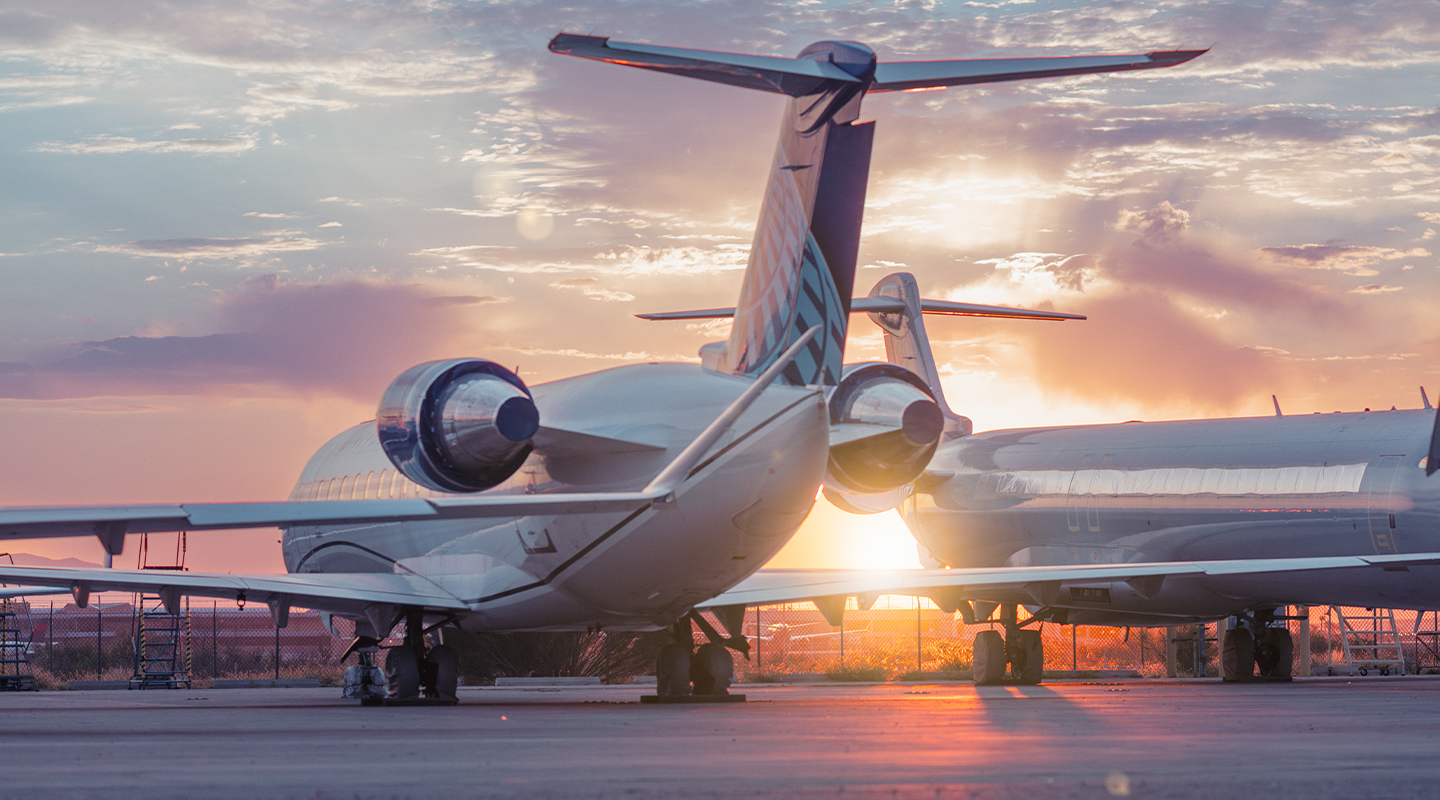
ATR BELIEVES THAT TURBOPROPS ARE POISED TO REPLACE 50-SEATER JETS. HERE’S WHY THEY'RE WRONG.
ATR has set its sights on the North American market, positioning its turboprops as the ideal replacement for ‘aging’ 50-seat regional jets. While they weave a good tale, they also reference an ‘imminent crisis’ that is completely made up.
It’s time to scrutinize the narrative. Here’s why ATR’s vision is fundamentally flawed:
THERE ARE MORE THAN ENOUGH 50-SEAT RJS TO FULFILL MARKET REQUIREMENTS FOR ANOTHER 20 YEARS.
Let’s start by setting the record straight: ATR claims that existing 50-seat Regional Jets are aging and will retire by the early 2030s.
While ATR claims that existing 50-seat Regional Jets are aging and will retire by the early 2030s, implying retirement by 45,000 and 48,000 cycles, most of these aircraft are in fact built for 60,000 to 80,000 cycles. This means that they have more than 15 to 20 years of operational life left.
The regional market today is not constrained by a lack of aircraft capacity, but by factors such as pilot shortages and rising labour costs.
OPERATIONAL REALITIES: RANGE, ECONOMICS AND SPEED
Recently, ATR stated that the 100NM to 400NM market represents an enormous opportunity to convert drivers into passengers, basing their logic on a “point-to-point model mostly seen in Europe. However, the U.S. market operates on a hub-and-spoke model with regional carriers playing a critical role in feeding connection networks.
Operators require flexibility in serving routes beyond 400NM where ATR aircraft are not suitable. Also, Hub-and-spoke means operating out of busy hub airports, where turboprops are usually too slow to intermix with jets, and their climb speed prevents them from using preferred departure routes.

While ATR may claim that they offer a 30% operating cost savings, they only refer to cash operating costs, not direct operating costs that would include the amortization and financing costs of a new aircraft. It is essential to look at the whole picture, as the minimal ownership costs of existing (and paid-off) 50-seat Regional Jets give them a net advantage and superior overall economics.
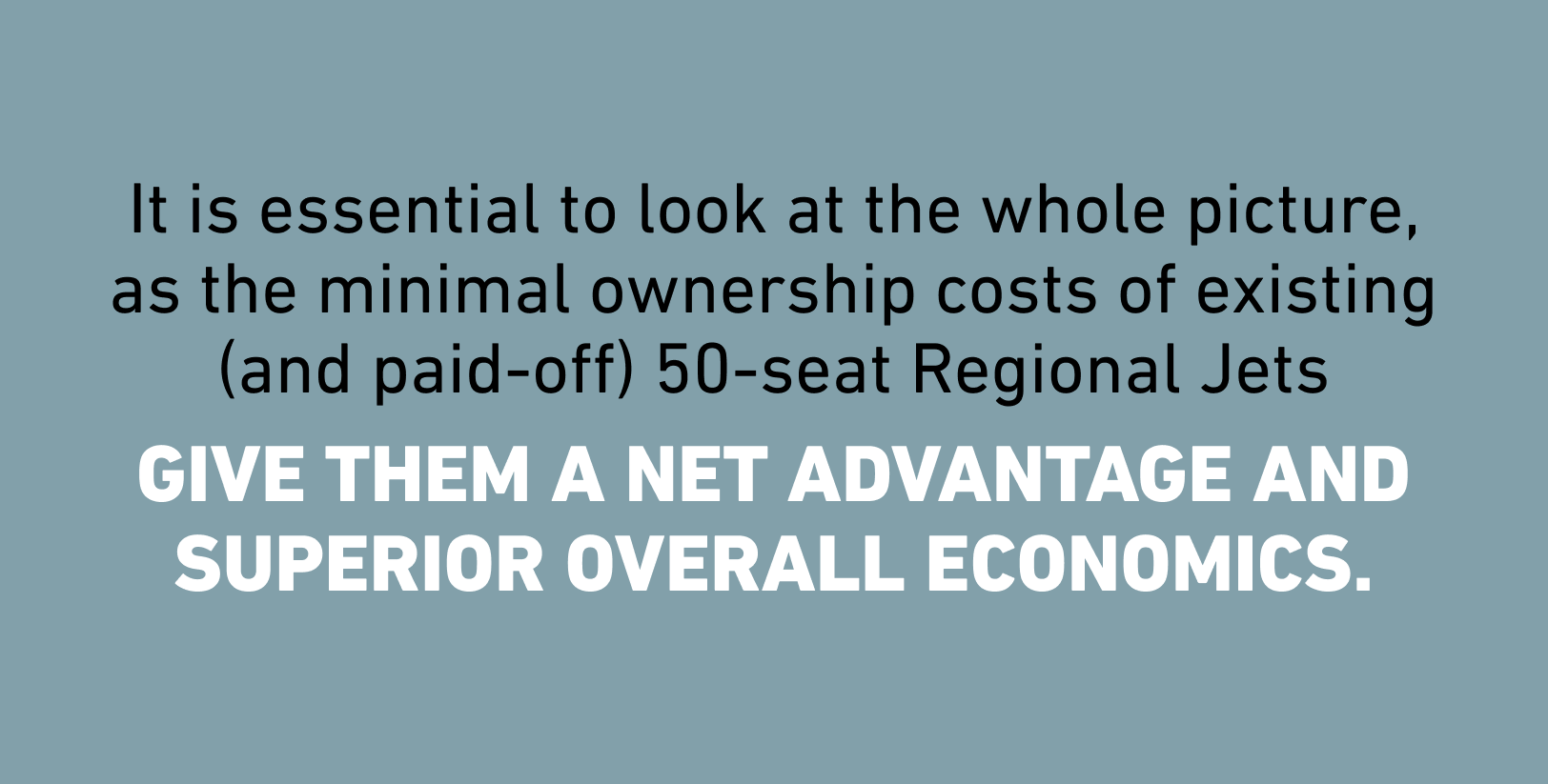
Moreover, turboprops may be efficient on short routes, but they’re not fast, with a cruise speed of Mach 0.45 versus RJs' 0.78, leading to 20 % longer flight times. Slower speeds mean more aircraft are needed to maintain frequency, increasing complexity and cost.
If operating the same network requires more aircraft, you’re not truly saving money at the network level, even if you were able to save money on an individual trip. It also means needing more pilots, an expensive and scarce resource that can’t be treated as a simple variable in an economic model.
Turboprops’ limited altitude and range restrict route flexibility hence why operators prefer using jets. In addition, ground handling and icing system limitations further weaken the operational case.
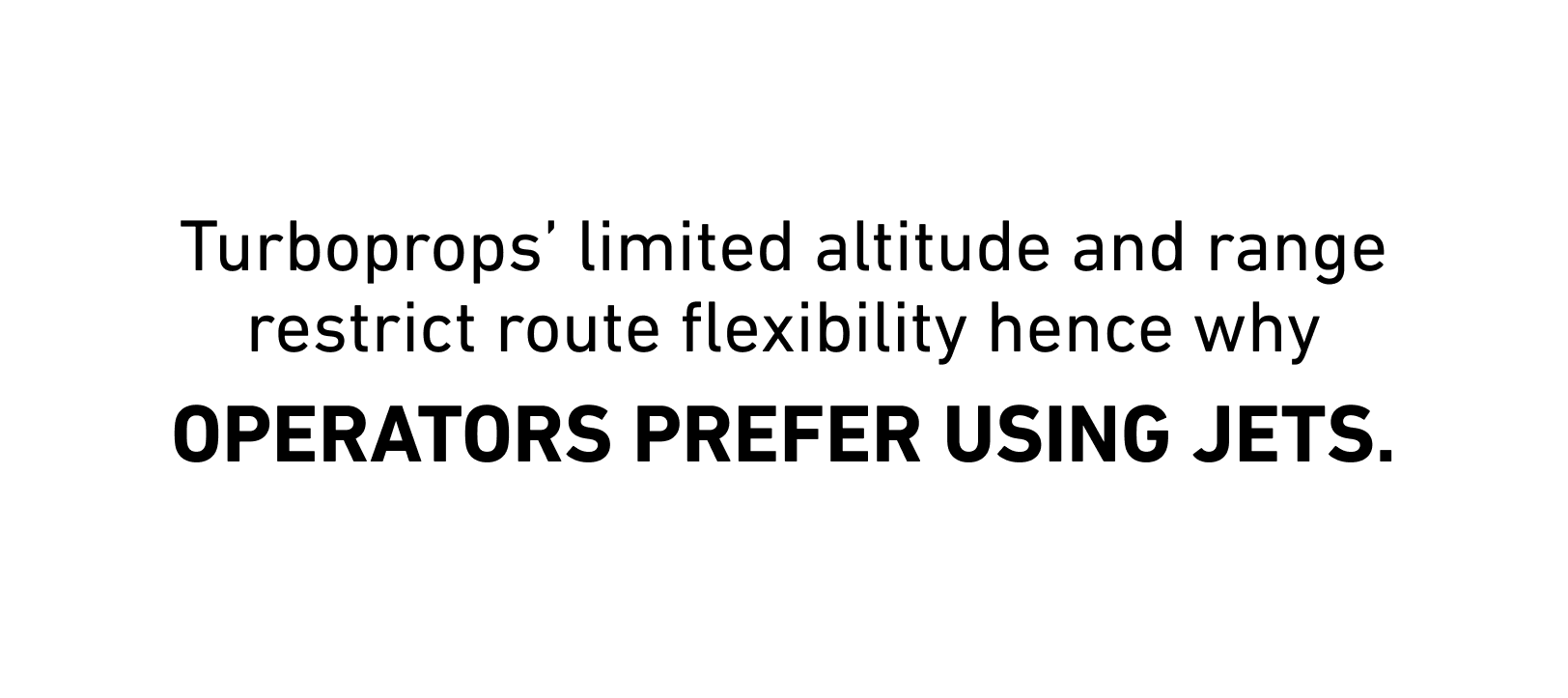
PERCEPTION MATTERS: TURBOPROPS STILL CARRY A STIGMA
Despite ATR’s marketing push, only 8 ATR aircraft are in commercial passenger operations in the U.S. Passengers perceive turboprops as noisy, slow, and less comfortable.
The reality for passengers is that ATR’s maximum altitude of 25,000 feet, compared to 41,000 feet for jets, prevents it from flying above weather, resulting in a rougher ride, more turbulence, and longer routes to avoid storms.
Changing that perception will require more than a rebrand; it demands a fundamental shift in experience, which ATR has yet to deliver.
MARKET HISTORY: LESSONS FROM THE Q400 AND SILVER AIRWAYS
History offers cautionary tales; major U.S. regional carriers have shifted toward fleet standardization by replacing turboprops with jets. Despite its impressive capabilities, the Bombardier Q400, later rebranded to De Havilland Dash 8-400, failed to gain traction in the U.S. market.
Silver Airways, a turboprop-heavy operator with a fleet of ATR 42 and ATR 72 aircraft, filed for bankruptcy in December 2024 and ceased operations in June 2025, citing mounting debt and operational challenges.
These stories underscore the difficulty in scaling turboprop operations in a jet-dominated landscape.
MARKET MOMENTUM: JETS AREN’T DECLINING; THEY’RE EVOLVING
Contrary to ATR’s narrative, regional jet utilization has been steady for the last 20 years, and operators are finding new ways to adapt their fleet as market dynamics evolve. MRO demand is projected to grow, with operators investing in upgrades rather than replacements.
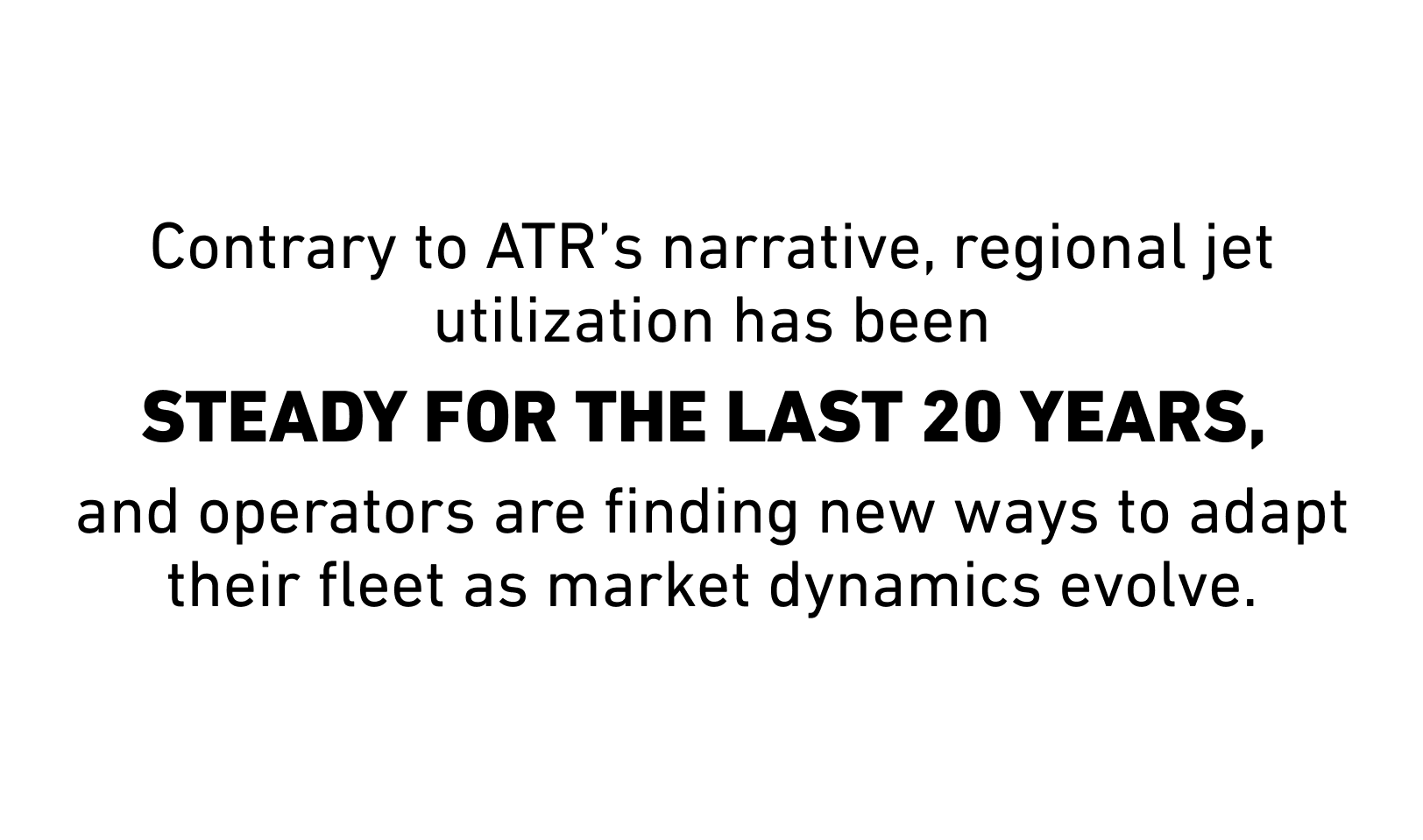
Maintaining on-time performance is critical to airline success, as passengers depend on timely connections and arrivals. The CRJ and ERJ fleets benefit from extensive spare parts availability, established MRO capacity and operational compatibility with mainline jet fleets. They offer superior performance across varied routes, better economics, and an enhanced customer experience. Their reliability and cost-efficiency, especially post-financing, make them the preferred choice for operators and passengers.

The market isn’t shrinking; it’s shifting toward more efficient jet configurations rather than turboprop substitutions.

ATR’s ambition to replace 50-seat RJs with turboprops is bold but misaligned with market realities. Limited support infrastructure in North America, scope clauses, operational limitations, historical failures, and entrenched perceptions form a formidable wall.
The future of regional aviation in North America lies not in reviving turboprops, but in evolving jets to meet new demands.
2 MIN- Log in to post comments
ATR THINKS THAT TURBOPROPS CAN REPLACE 50-SEATER JETS: HERE'S WHY THEY'RE WRONG.

ATR BELIEVES THAT TURBOPROPS ARE POISED TO REPLACE 50-SEATER JETS. HERE’S WHY THEY'RE WRONG.
ATR has set its sights on the North American market, positioning its turboprops as the ideal replacement for ‘aging’ 50-seat regional jets. While they weave a good tale, they also reference an ‘imminent crisis’ that is completely made up.
It’s time to scrutinize the narrative. Here’s why ATR’s vision is fundamentally flawed:
THERE ARE MORE THAN ENOUGH 50-SEAT RJS TO FULFILL MARKET REQUIREMENTS FOR ANOTHER 20 YEARS.
Let’s start by setting the record straight: ATR claims that existing 50-seat Regional Jets are aging and will retire by the early 2030s.
While ATR claims that existing 50-seat Regional Jets are aging and will retire by the early 2030s, implying retirement by 45,000 and 48,000 cycles, most of these aircraft are in fact built for 60,000 to 80,000 cycles. This means that they have more than 15 to 20 years of operational life left.
The regional market today is not constrained by a lack of aircraft capacity, but by factors such as pilot shortages and rising labour costs.
OPERATIONAL REALITIES: RANGE, ECONOMICS AND SPEED
Recently, ATR stated that the 100NM to 400NM market represents an enormous opportunity to convert drivers into passengers, basing their logic on a “point-to-point model mostly seen in Europe. However, the U.S. market operates on a hub-and-spoke model with regional carriers playing a critical role in feeding connection networks.
Operators require flexibility in serving routes beyond 400NM where ATR aircraft are not suitable. Also, Hub-and-spoke means operating out of busy hub airports, where turboprops are usually too slow to intermix with jets, and their climb speed prevents them from using preferred departure routes.

While ATR may claim that they offer a 30% operating cost savings, they only refer to cash operating costs, not direct operating costs that would include the amortization and financing costs of a new aircraft. It is essential to look at the whole picture, as the minimal ownership costs of existing (and paid-off) 50-seat Regional Jets give them a net advantage and superior overall economics.

Moreover, turboprops may be efficient on short routes, but they’re not fast, with a cruise speed of Mach 0.45 versus RJs' 0.78, leading to 20 % longer flight times. Slower speeds mean more aircraft are needed to maintain frequency, increasing complexity and cost.
If operating the same network requires more aircraft, you’re not truly saving money at the network level, even if you were able to save money on an individual trip. It also means needing more pilots, an expensive and scarce resource that can’t be treated as a simple variable in an economic model.
Turboprops’ limited altitude and range restrict route flexibility hence why operators prefer using jets. In addition, ground handling and icing system limitations further weaken the operational case.

PERCEPTION MATTERS: TURBOPROPS STILL CARRY A STIGMA
Despite ATR’s marketing push, only 8 ATR aircraft are in commercial passenger operations in the U.S. Passengers perceive turboprops as noisy, slow, and less comfortable.
The reality for passengers is that ATR’s maximum altitude of 25,000 feet, compared to 41,000 feet for jets, prevents it from flying above weather, resulting in a rougher ride, more turbulence, and longer routes to avoid storms.
Changing that perception will require more than a rebrand; it demands a fundamental shift in experience, which ATR has yet to deliver.
MARKET HISTORY: LESSONS FROM THE Q400 AND SILVER AIRWAYS
History offers cautionary tales; major U.S. regional carriers have shifted toward fleet standardization by replacing turboprops with jets. Despite its impressive capabilities, the Bombardier Q400, later rebranded to De Havilland Dash 8-400, failed to gain traction in the U.S. market.
Silver Airways, a turboprop-heavy operator with a fleet of ATR 42 and ATR 72 aircraft, filed for bankruptcy in December 2024 and ceased operations in June 2025, citing mounting debt and operational challenges.
These stories underscore the difficulty in scaling turboprop operations in a jet-dominated landscape.
MARKET MOMENTUM: JETS AREN’T DECLINING; THEY’RE EVOLVING
Contrary to ATR’s narrative, regional jet utilization has been steady for the last 20 years, and operators are finding new ways to adapt their fleet as market dynamics evolve. MRO demand is projected to grow, with operators investing in upgrades rather than replacements.

Maintaining on-time performance is critical to airline success, as passengers depend on timely connections and arrivals. The CRJ and ERJ fleets benefit from extensive spare parts availability, established MRO capacity and operational compatibility with mainline jet fleets. They offer superior performance across varied routes, better economics, and an enhanced customer experience. Their reliability and cost-efficiency, especially post-financing, make them the preferred choice for operators and passengers.

The market isn’t shrinking; it’s shifting toward more efficient jet configurations rather than turboprop substitutions.

ATR’s ambition to replace 50-seat RJs with turboprops is bold but misaligned with market realities. Limited support infrastructure in North America, scope clauses, operational limitations, historical failures, and entrenched perceptions form a formidable wall.
The future of regional aviation in North America lies not in reviving turboprops, but in evolving jets to meet new demands.
2 MIN- Log in to post comments
-
Conversations with our Leaders: Timothy Wang, Endeavor Air

At the Regional Airline Association’s 50th Anniversary, we spoke with Timothy Wang, President and CEO of Endeavor Air, to discuss the state of regional aviation and where it’s headed next. From industry-wide alignment to modernization, Wang shared his perspective on both the challenges and the opportunities shaping this pivotal moment in aviation.
MHIRJ: Hi Timothy, tell us about the event and what you're here to talk about.
Timothy: It is the RAA's 50th anniversary, representing years and decades of great work advancing the interests of our industry and of our regional community.
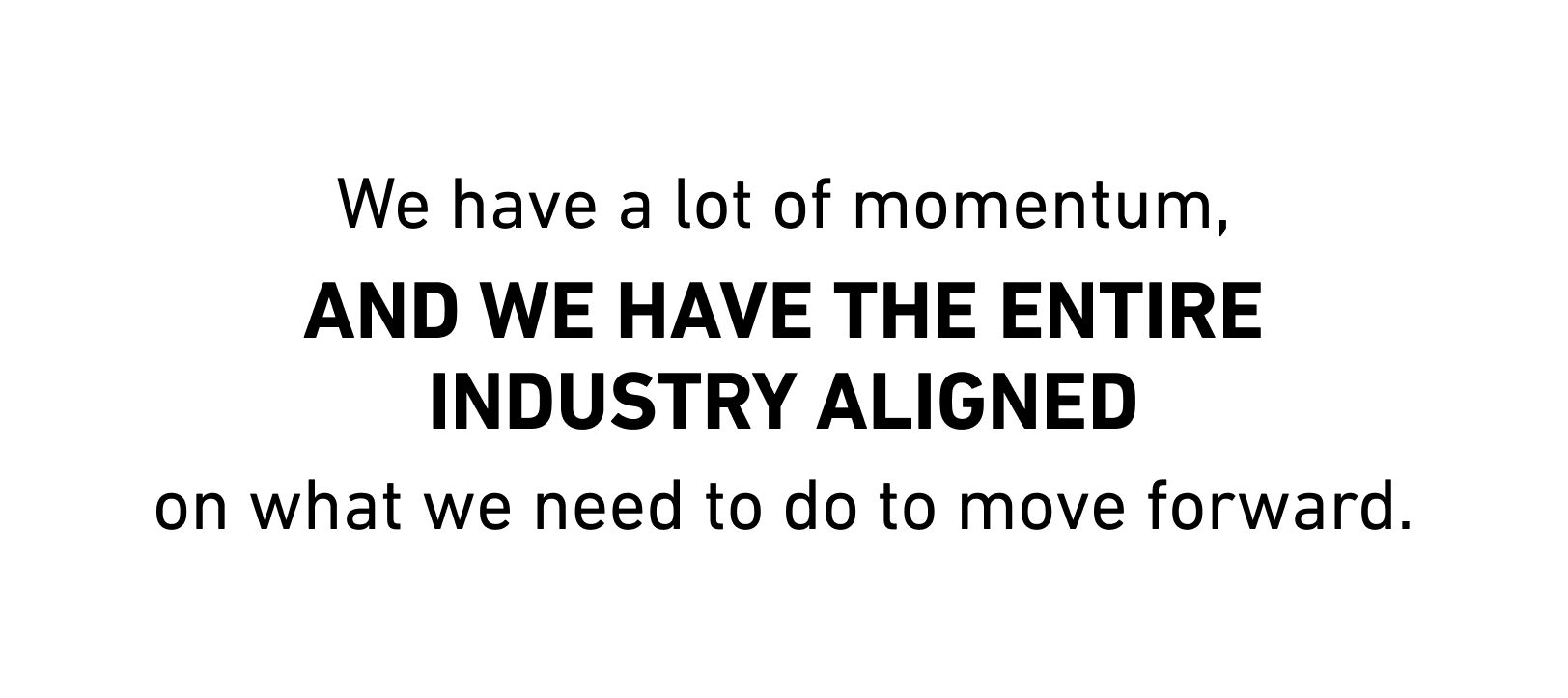
MHIRJ: What's top of mind this year?
Timothy: For the first time in quite a while, we have a lot of momentum, and we have the entire industry aligned on what we need to do to move forward. The ATC Modernization Project, which has been funded to the tune of $12.5 billion, is a great start. It's a great down payment of where we need to go. We've heard this time and time again. It's no secret that the technology that's employed at ATC today is quite dated. A lot of it from 80s and 90s. It's inconsistent and we need to bring that well into the 21st century.
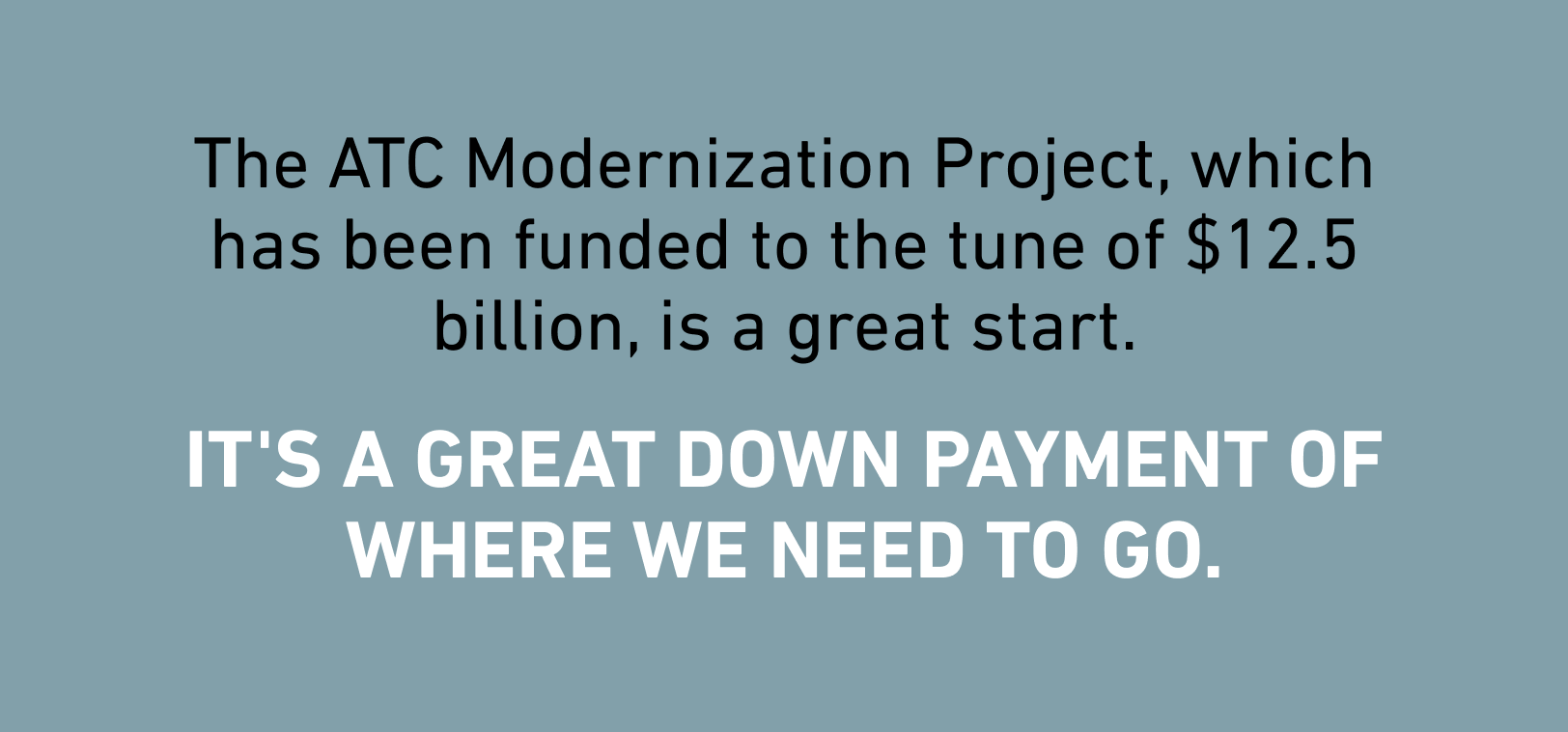
MHIRJ: How do you feel about the commitments so far?
Timothy: I'm extraordinarily optimistic. I think for the first time in quite a while, we have a secretary who is laser focused on air travel, understanding the need in this country for that essential service. We have an administrator who many of us in this community know very well. Until very recently, in his confirmation, Bryan Bedford was CEO of Republic Airways, right here in the RAA. So, he's a great member, great friend, great ally for us. And we know that they understand exactly what they need to do to propel this industry forward.
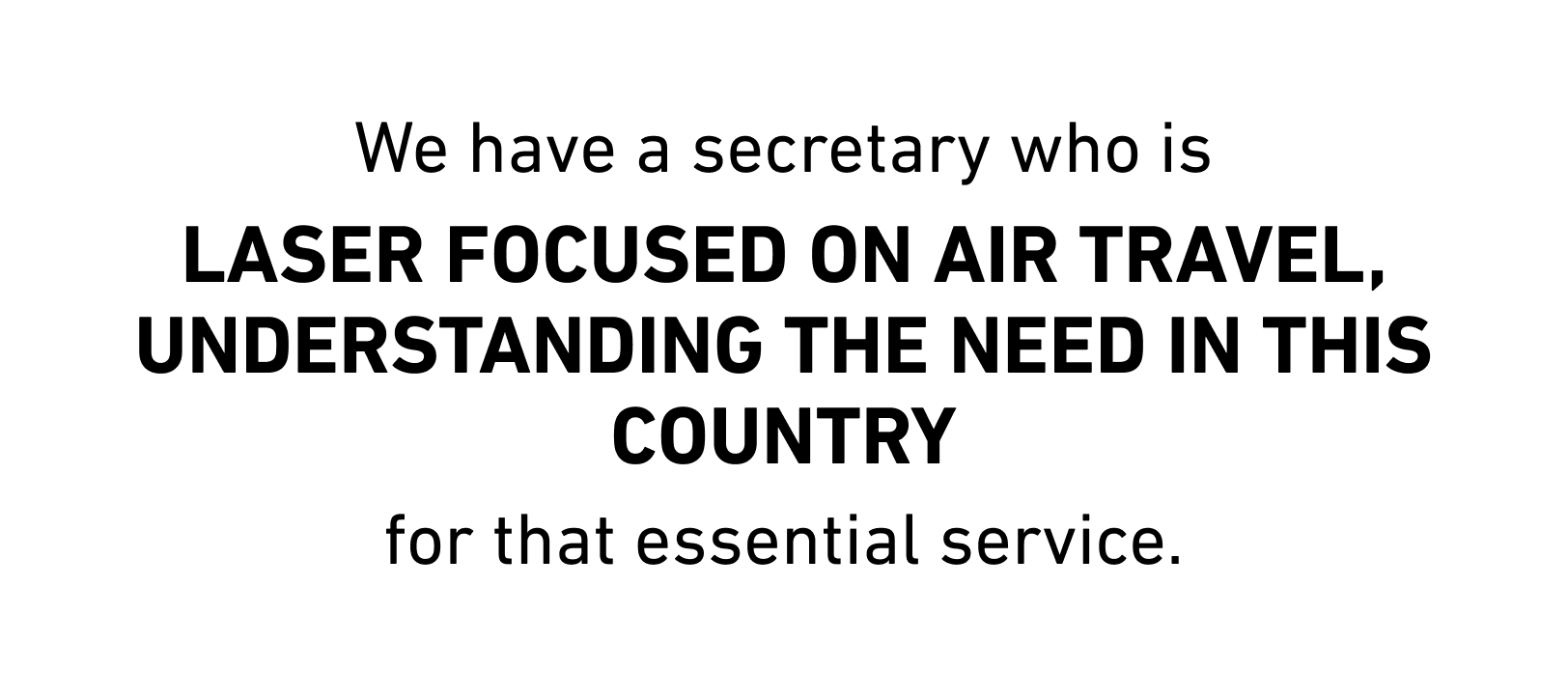
MHIRJ: Why do regional airlines matter?
Timothy: I grew up in a smaller community. A lot of people who live in big hubs don't quite know this, but the majority of the geography of this country is served by regional airlines and regional airports only. It is an essential lifeline, not just for people who have to get to the most important moments of their lives, whether it's a wedding, it's a graduation, it's visiting a friend, taking their families on vacation. But also, a necessary lifeline for economic development. That's how we create jobs.
I worked in the economic development field many, many years ago down in Alabama. And one of the things that the executives of companies looking to open up new facilities and create jobs in Alabama asked was, how do we get our people and our products and our parts in and out of the community? We're very proud to be part of that ecosystem.
MHIRJ: Celebrating 50 years of RAA, what’s your message to the team?
Congratulations. It's an incredible milestone, an incredible achievement. This group does such a great job of advocating on behalf of all of our members on advancing our cause, which ultimately isn't an industry cause. It's a cause for the people of this country. I'm very excited to be here. I'm excited to see how the rest of this week unfolds and appreciate RAA and everybody involved in it and the support they give us.
2 MIN- Log in to post comments
Conversations with our Leaders: Timothy Wang, Endeavor Air

At the Regional Airline Association’s 50th Anniversary, we spoke with Timothy Wang, President and CEO of Endeavor Air, to discuss the state of regional aviation and where it’s headed next. From industry-wide alignment to modernization, Wang shared his perspective on both the challenges and the opportunities shaping this pivotal moment in aviation.
MHIRJ: Hi Timothy, tell us about the event and what you're here to talk about.
Timothy: It is the RAA's 50th anniversary, representing years and decades of great work advancing the interests of our industry and of our regional community.

MHIRJ: What's top of mind this year?
Timothy: For the first time in quite a while, we have a lot of momentum, and we have the entire industry aligned on what we need to do to move forward. The ATC Modernization Project, which has been funded to the tune of $12.5 billion, is a great start. It's a great down payment of where we need to go. We've heard this time and time again. It's no secret that the technology that's employed at ATC today is quite dated. A lot of it from 80s and 90s. It's inconsistent and we need to bring that well into the 21st century.

MHIRJ: How do you feel about the commitments so far?
Timothy: I'm extraordinarily optimistic. I think for the first time in quite a while, we have a secretary who is laser focused on air travel, understanding the need in this country for that essential service. We have an administrator who many of us in this community know very well. Until very recently, in his confirmation, Bryan Bedford was CEO of Republic Airways, right here in the RAA. So, he's a great member, great friend, great ally for us. And we know that they understand exactly what they need to do to propel this industry forward.

MHIRJ: Why do regional airlines matter?
Timothy: I grew up in a smaller community. A lot of people who live in big hubs don't quite know this, but the majority of the geography of this country is served by regional airlines and regional airports only. It is an essential lifeline, not just for people who have to get to the most important moments of their lives, whether it's a wedding, it's a graduation, it's visiting a friend, taking their families on vacation. But also, a necessary lifeline for economic development. That's how we create jobs.
I worked in the economic development field many, many years ago down in Alabama. And one of the things that the executives of companies looking to open up new facilities and create jobs in Alabama asked was, how do we get our people and our products and our parts in and out of the community? We're very proud to be part of that ecosystem.
MHIRJ: Celebrating 50 years of RAA, what’s your message to the team?
Congratulations. It's an incredible milestone, an incredible achievement. This group does such a great job of advocating on behalf of all of our members on advancing our cause, which ultimately isn't an industry cause. It's a cause for the people of this country. I'm very excited to be here. I'm excited to see how the rest of this week unfolds and appreciate RAA and everybody involved in it and the support they give us.
2 MIN- Log in to post comments
-
RAA 2025 Leaders Conference Celebrates 50 Years

Washington D.C Hosts Regional Aviation Leaders
Aviation leaders from across North America gathered in Washington, DC for the 2025 Regional Airline Association Leaders Conference this past September. This year marked a major milestone: the 50th anniversary of the Regional Airline Association (RAA). Over three days in September, airline executives, industry partners, and policymakers gathered to discuss the future of regional air service, workforce challenges, and modernization opportunities.
MHIRJ as a Diamond Sponsor at RAA 2025
MHIRJ was proud to participate as a Diamond level sponsor, joining key players in the regional aviation ecosystem. The company contributed to high-level conversations shaping the future of aviation and reaffirmed its commitment to supporting safe, reliable, and accessible air service.
“Bringing leaders together from across regional aviation fosters a direct exchange of insights, challenges, and strategies. Events like the RAA Leaders Conference bring focus on our common mission to advance regional air service and accelerate collaborative solutions that benefit the entire industry,” said Stephanie Bento, Government & Industry Affairs Lead, MHIRJ


Celebrating 50 Years of Regional Airline Advocacy
Founded on September 26, 1975, the RAA—originally the Commuter Airline Association of America—began as a small coalition advocating for fair representation of regional carriers. Today, it stands as a powerful voice for regional aviation, supported by its members, partners, and volunteers.
“RAA has been a steadfast advocate for regional aviation, championing safety, small community air service, and operational excellence. This anniversary is a testament to the dedication that all of you in this room have shown along the way,” said Faye Malarkey Black, President & CEO of RAA

Regional Airlines: Backbone of U.S. Air Connectivity
RAA’s influence spans the entire U.S. aviation landscape. In 2024, regional airlines served 635 airports, with 94.5% of all U.S. airports receiving scheduled passenger service from regional carriers. In many states, regional airlines provide 64% of passengers’ only source of air service, making their role essential to national connectivity.

Key Topics: ATC Modernization, Workforce, and Aircraft Lifecycle
The conference featured a focus on ATC modernization, continued efforts to focus on safe and strong regional airline workforce, labor shortages, and business trends. Panelists and policymakers discussed strategies for collaboration between airlines, challenges in workforce, and debated falsities in interpretations of industry forecasts and the future of regional aircraft. When the misconception that 50-seater aircraft is at the end of its lifecycle became a topic, it was fiercely defended in front of a full crowd of attendees. “Let me start by dispelling a myth... 50 seat aircraft are nowhere near the end of their life. That is a falsehood. The airplanes were built for 80,000 cycles. Most of them are at 30-40,000 cycles today. So they have plenty of life left ahead of them,” said Ross Mitchell, SVP Strategy, Business Development & Communications, MHIRJ


Looking Ahead: The Future of Regional Aviation
Spirited conversations like these are crucial to ensuring small and rural communities remain connected to the national transportation network. MHIRJ looks forward to building on the momentum of this milestone event and continuing to advance regional aviation for the next fifty years.
Learn more at raa.org
3 MIN- Log in to post comments
RAA 2025 Leaders Conference Celebrates 50 Years

Washington D.C Hosts Regional Aviation Leaders
Aviation leaders from across North America gathered in Washington, DC for the 2025 Regional Airline Association Leaders Conference this past September. This year marked a major milestone: the 50th anniversary of the Regional Airline Association (RAA). Over three days in September, airline executives, industry partners, and policymakers gathered to discuss the future of regional air service, workforce challenges, and modernization opportunities.
MHIRJ as a Diamond Sponsor at RAA 2025
MHIRJ was proud to participate as a Diamond level sponsor, joining key players in the regional aviation ecosystem. The company contributed to high-level conversations shaping the future of aviation and reaffirmed its commitment to supporting safe, reliable, and accessible air service.
“Bringing leaders together from across regional aviation fosters a direct exchange of insights, challenges, and strategies. Events like the RAA Leaders Conference bring focus on our common mission to advance regional air service and accelerate collaborative solutions that benefit the entire industry,” said Stephanie Bento, Government & Industry Affairs Lead, MHIRJ


Celebrating 50 Years of Regional Airline Advocacy
Founded on September 26, 1975, the RAA—originally the Commuter Airline Association of America—began as a small coalition advocating for fair representation of regional carriers. Today, it stands as a powerful voice for regional aviation, supported by its members, partners, and volunteers.
“RAA has been a steadfast advocate for regional aviation, championing safety, small community air service, and operational excellence. This anniversary is a testament to the dedication that all of you in this room have shown along the way,” said Faye Malarkey Black, President & CEO of RAA

Regional Airlines: Backbone of U.S. Air Connectivity
RAA’s influence spans the entire U.S. aviation landscape. In 2024, regional airlines served 635 airports, with 94.5% of all U.S. airports receiving scheduled passenger service from regional carriers. In many states, regional airlines provide 64% of passengers’ only source of air service, making their role essential to national connectivity.

Key Topics: ATC Modernization, Workforce, and Aircraft Lifecycle
The conference featured a focus on ATC modernization, continued efforts to focus on safe and strong regional airline workforce, labor shortages, and business trends. Panelists and policymakers discussed strategies for collaboration between airlines, challenges in workforce, and debated falsities in interpretations of industry forecasts and the future of regional aircraft. When the misconception that 50-seater aircraft is at the end of its lifecycle became a topic, it was fiercely defended in front of a full crowd of attendees. “Let me start by dispelling a myth... 50 seat aircraft are nowhere near the end of their life. That is a falsehood. The airplanes were built for 80,000 cycles. Most of them are at 30-40,000 cycles today. So they have plenty of life left ahead of them,” said Ross Mitchell, SVP Strategy, Business Development & Communications, MHIRJ


Looking Ahead: The Future of Regional Aviation
Spirited conversations like these are crucial to ensuring small and rural communities remain connected to the national transportation network. MHIRJ looks forward to building on the momentum of this milestone event and continuing to advance regional aviation for the next fifty years.
Learn more at raa.org
3 MIN- Log in to post comments
-
REGIONAL JETS ARE STICKING AROUND: HERE’S WHY
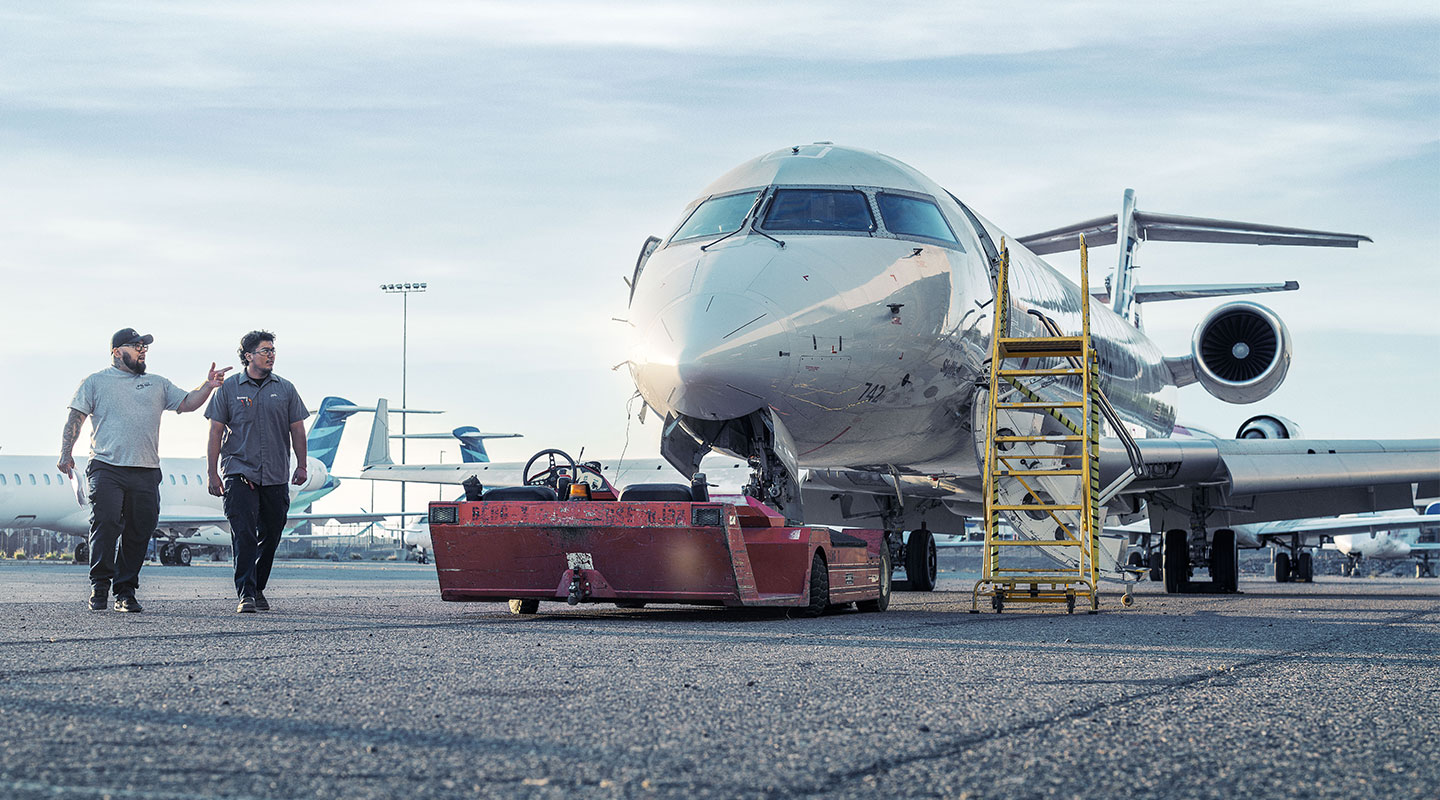
Despite predictions of decline, regional aircraft continue to play a critical role in aviation. Shifting market conditions, delayed retirements, and rising utilization are all contributing to the extended lifespan of regional fleets, keeping maintenance demand strong for many years to come.

While some industry forecasts predicted a drop in regional jet maintenance demand, expecting retirements to outpace renewals, the reality has been very different. Operators are holding onto their existing fleets longer—a decision driven by market volatility, and the lack of a compelling replacement. The result? Maintenance demand is trending positively, not shrinking.
Utilization has climbed significantly across North America, the world’s largest regional jet market, which accounts for 55% of the global regional fleet. Aircraft that were once predicted to get phased out are being taken out of retirement to meet the demand of new or reinstated regional routes, driving additional demand for MRO support.
This trend is especially noticeable with the CRJ Series fleet. While some jets are starting to retire, they are not exiting as quickly as some reports suggest. In fact, the CRJ remains a hot commodity in the trading market. Each time ownership changes hands, it sparks a new wave of MRO work, from preparing aircraft for redelivery to reconfiguring cabins, installing Wi-Fi, and aligning with the new operator’s specifications. So instead of a sharp drop in fleet size, we’re seeing more of a plateau and a steady stream of ongoing maintenance needs.
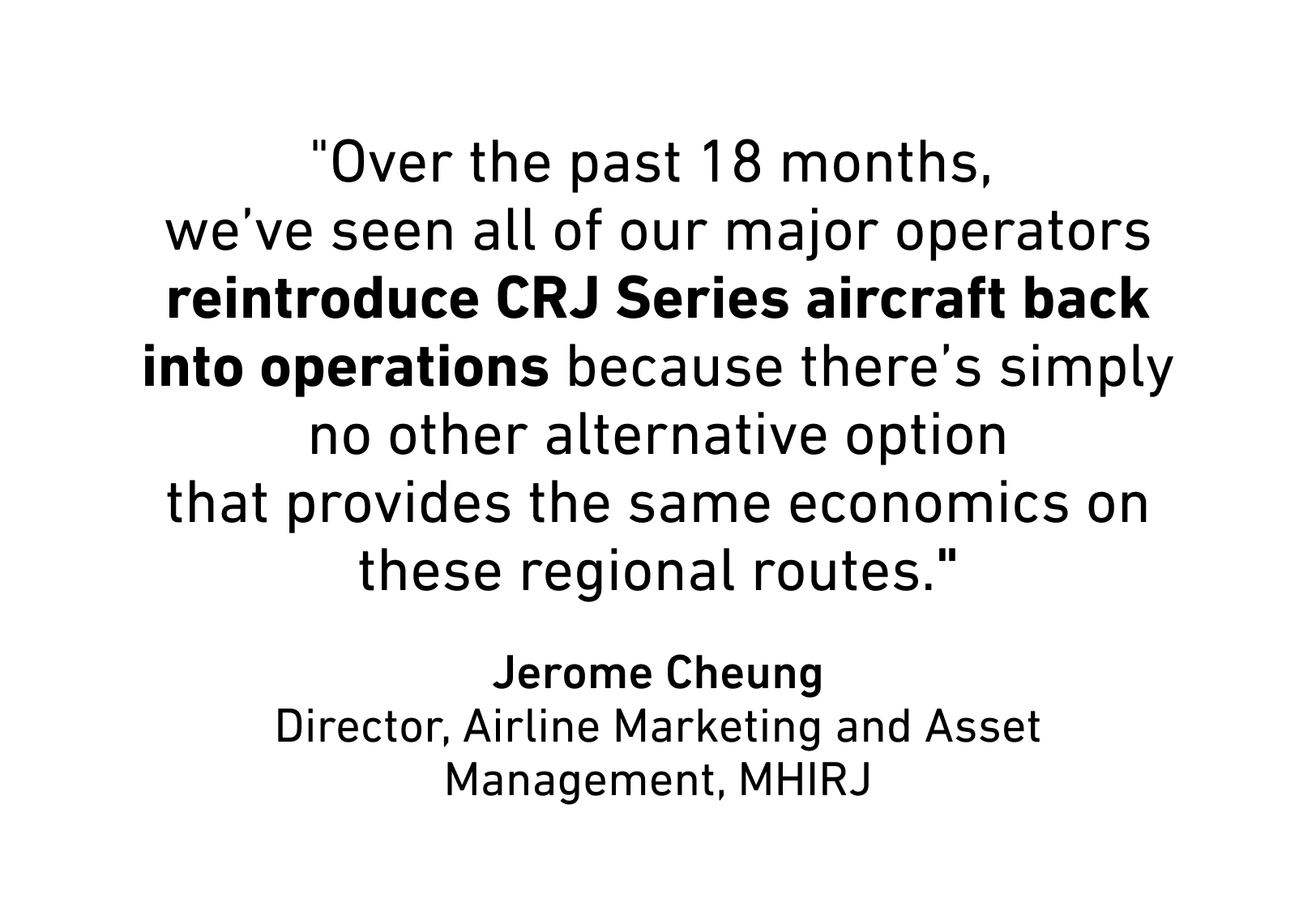
UTILIZATION DRIVES DEMAND
Data shows that regional jet utilization has fully recovered from the COVID-era slowdown and is now trending higher. Increased flight hours and utilization are driving up the need for aircraft maintenance, product support, and parts.
Oliver Wyman’s latest outlook projects regional MRO demand to grow from $5.7B in 2025 to $6.1B by 2035. While not explosive growth, it is steady, and most importantly, positive. This incremental climb reinforces the fact that regional aircraft remain an essential and profitable segment of the market.
Ross Mitchell, MHIRJ's Senior Vice President of Strategy and Business Development, comments that operators are making strategic decisions that keep their fleets in service longer, maximizing fleet longevity.
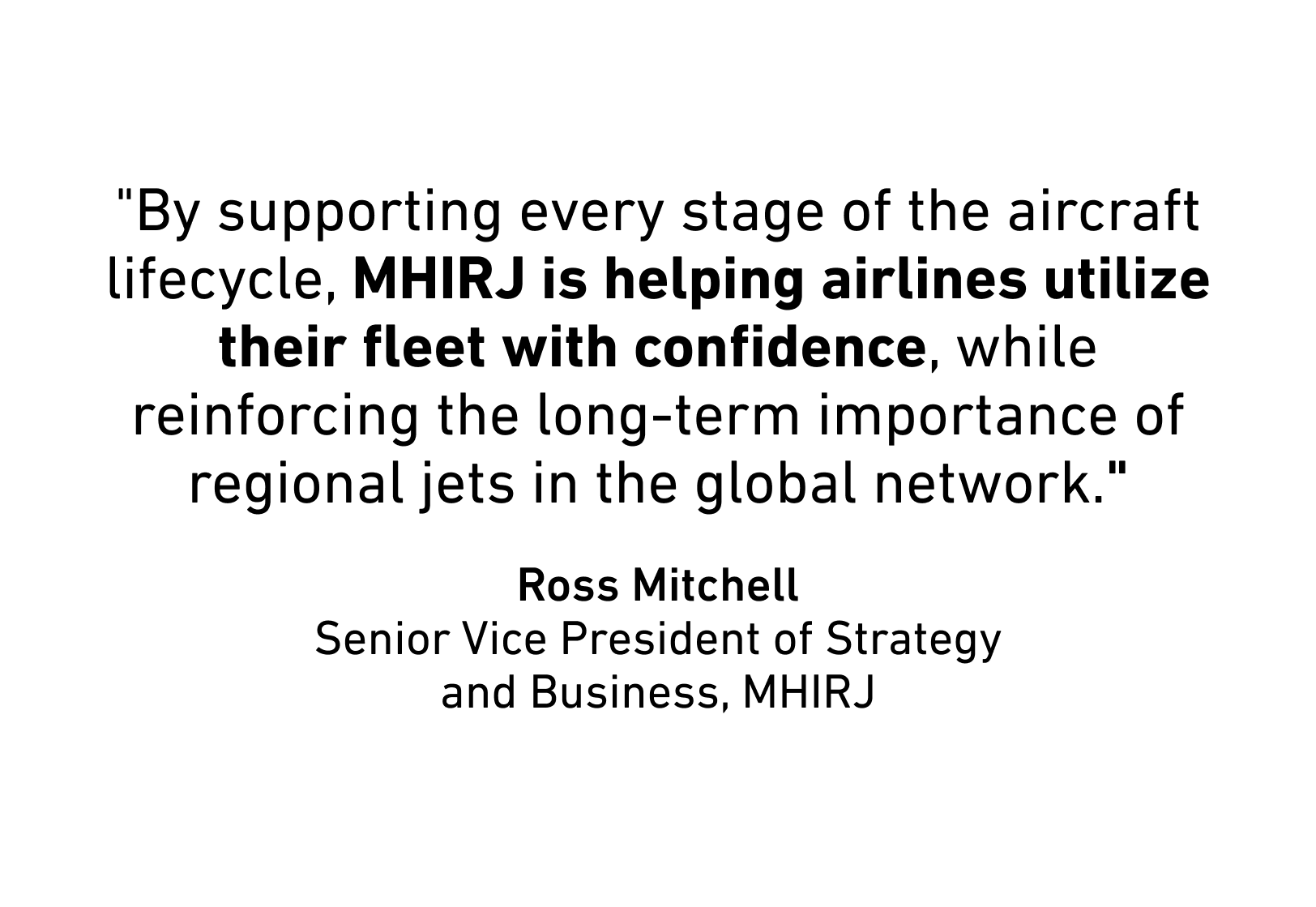
A RESILIENT FUTURE FOR REGIONAL AVIATION
Far from fading, regional aviation is proving its resilience. The majority of CRJ aircraft are owned by the airlines with no ongoing financing obligations, making them cost-efficient to operate and maintain. Combined with proven reliability, lower direct operating costs, and strong customer commitment, they remain highly valuable.
Ultimately, the message is clear: regional aircraft are here to stay. And with them, a growing demand for the critical services that keep them flying.
3 MIN- Log in to post comments
REGIONAL JETS ARE STICKING AROUND: HERE’S WHY

Despite predictions of decline, regional aircraft continue to play a critical role in aviation. Shifting market conditions, delayed retirements, and rising utilization are all contributing to the extended lifespan of regional fleets, keeping maintenance demand strong for many years to come.

While some industry forecasts predicted a drop in regional jet maintenance demand, expecting retirements to outpace renewals, the reality has been very different. Operators are holding onto their existing fleets longer—a decision driven by market volatility, and the lack of a compelling replacement. The result? Maintenance demand is trending positively, not shrinking.
Utilization has climbed significantly across North America, the world’s largest regional jet market, which accounts for 55% of the global regional fleet. Aircraft that were once predicted to get phased out are being taken out of retirement to meet the demand of new or reinstated regional routes, driving additional demand for MRO support.
This trend is especially noticeable with the CRJ Series fleet. While some jets are starting to retire, they are not exiting as quickly as some reports suggest. In fact, the CRJ remains a hot commodity in the trading market. Each time ownership changes hands, it sparks a new wave of MRO work, from preparing aircraft for redelivery to reconfiguring cabins, installing Wi-Fi, and aligning with the new operator’s specifications. So instead of a sharp drop in fleet size, we’re seeing more of a plateau and a steady stream of ongoing maintenance needs.

UTILIZATION DRIVES DEMAND
Data shows that regional jet utilization has fully recovered from the COVID-era slowdown and is now trending higher. Increased flight hours and utilization are driving up the need for aircraft maintenance, product support, and parts.
Oliver Wyman’s latest outlook projects regional MRO demand to grow from $5.7B in 2025 to $6.1B by 2035. While not explosive growth, it is steady, and most importantly, positive. This incremental climb reinforces the fact that regional aircraft remain an essential and profitable segment of the market.
Ross Mitchell, MHIRJ's Senior Vice President of Strategy and Business Development, comments that operators are making strategic decisions that keep their fleets in service longer, maximizing fleet longevity.

A RESILIENT FUTURE FOR REGIONAL AVIATION
Far from fading, regional aviation is proving its resilience. The majority of CRJ aircraft are owned by the airlines with no ongoing financing obligations, making them cost-efficient to operate and maintain. Combined with proven reliability, lower direct operating costs, and strong customer commitment, they remain highly valuable.
Ultimately, the message is clear: regional aircraft are here to stay. And with them, a growing demand for the critical services that keep them flying.
3 MIN- Log in to post comments
-
MHIRJ AND THE CARL HOPKINS WV YOUTH AVIATION EXPO
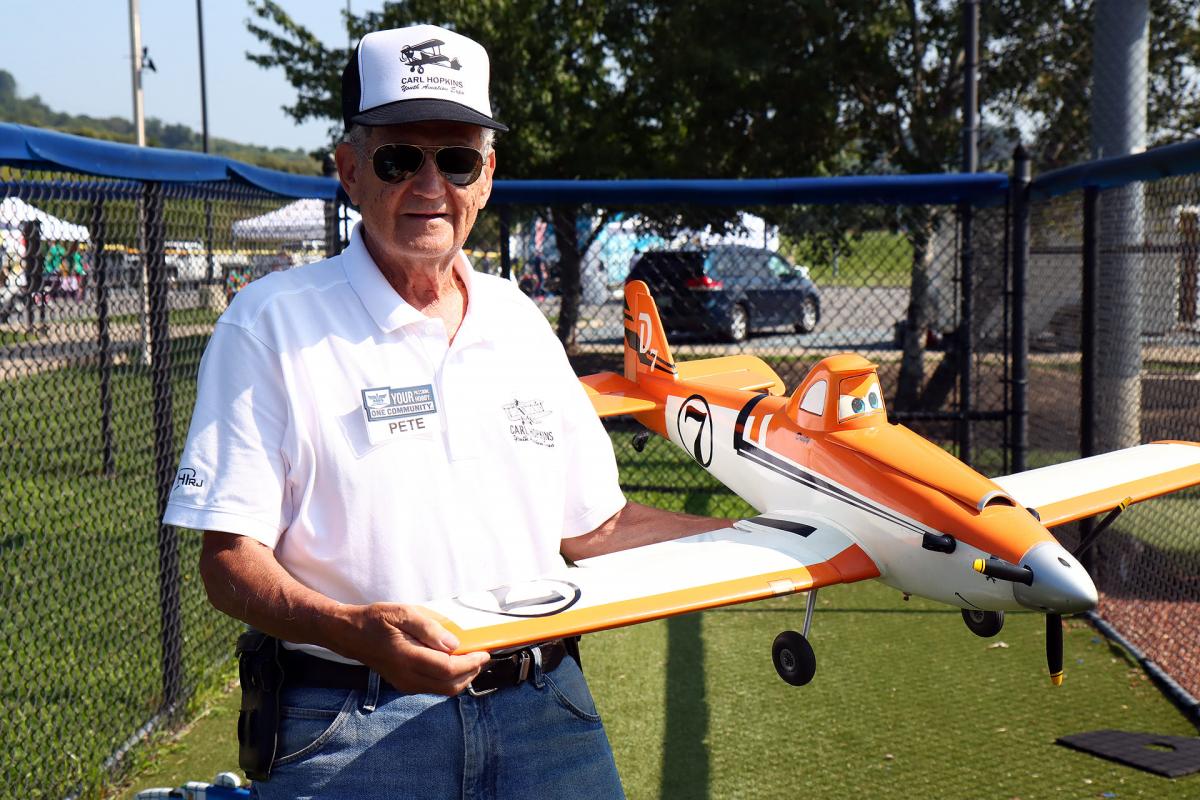
TAKING FLIGHT AT THE CARL HOPKINS WV YOUTH AVIATION EXPO
If you’re looking for the perfect blend of excitement, learning, and community spirit, look no further than the Carl Hopkins WV Youth Aviation Expo. Named after the inspiring founder of West Virginia's first model aviation club in 1928, this annual event has become a beacon of opportunity and connection in Bridgeport, WV.
The 5th edition of the Expo, took place on August 8 and 9, at The Bridge Sports Complex, bringing together educators, aviation experts, local businesses, and community leaders, all united by a common goal: to ignite a passion for aviation in the hearts of young people.
A DAY OF HANDS-ON LEARNING
Participants were treated to a day packed with engaging activities. From building their very own model airplanes to experiencing control line and remote-control flights, there was something for everyone. Attendees were thrilled to watch live drone demonstrations and launch rockets, with all necessary supplies provided for them to take home.
Special attractions included fly-ins of Blackhawk helicopters and thrilling paramotor and parachute displays. College representatives and corporate sponsors connected aspiring aviators with future opportunities.
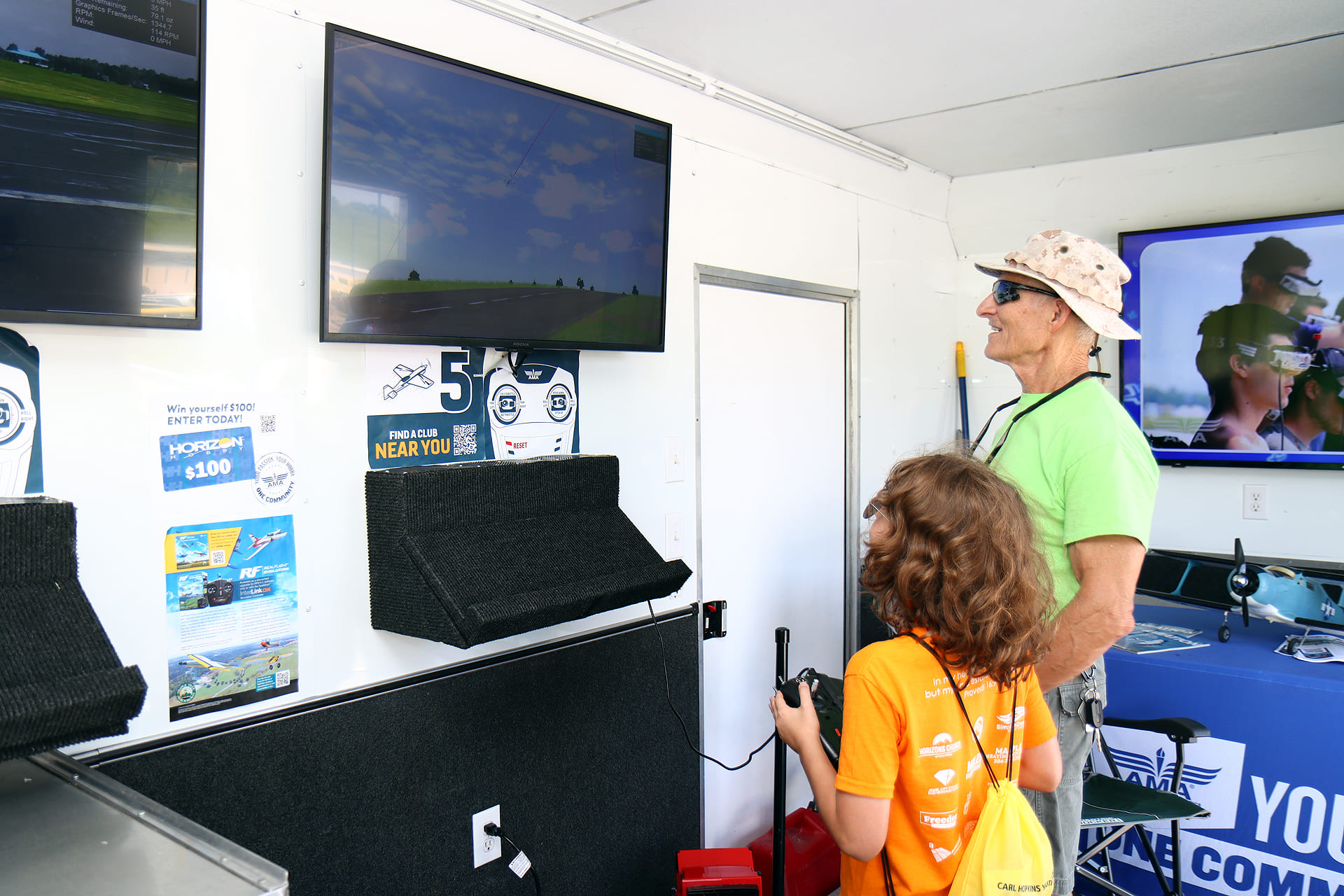
FAMILIES FLYING TOGETHER
What truly stood out at the Expo was the sense of community and bonding. For many families, this event wasn’t just a fun day out—it was an opportunity to create lasting memories together. Children and adults alike discovered new interests, learning collaboratively and cheering each other on. Whether it was assembling model airplanes or listening to stories from experienced pilots, the day served as a reminder that learning is a lifelong journey best shared.
Parents looked on with pride as their children unleashed their creativity, building rockets and exploring the world of aviation. The hands-on nature of the activities instilled a spirit of exploration and innovation in the hearts of the young participants.
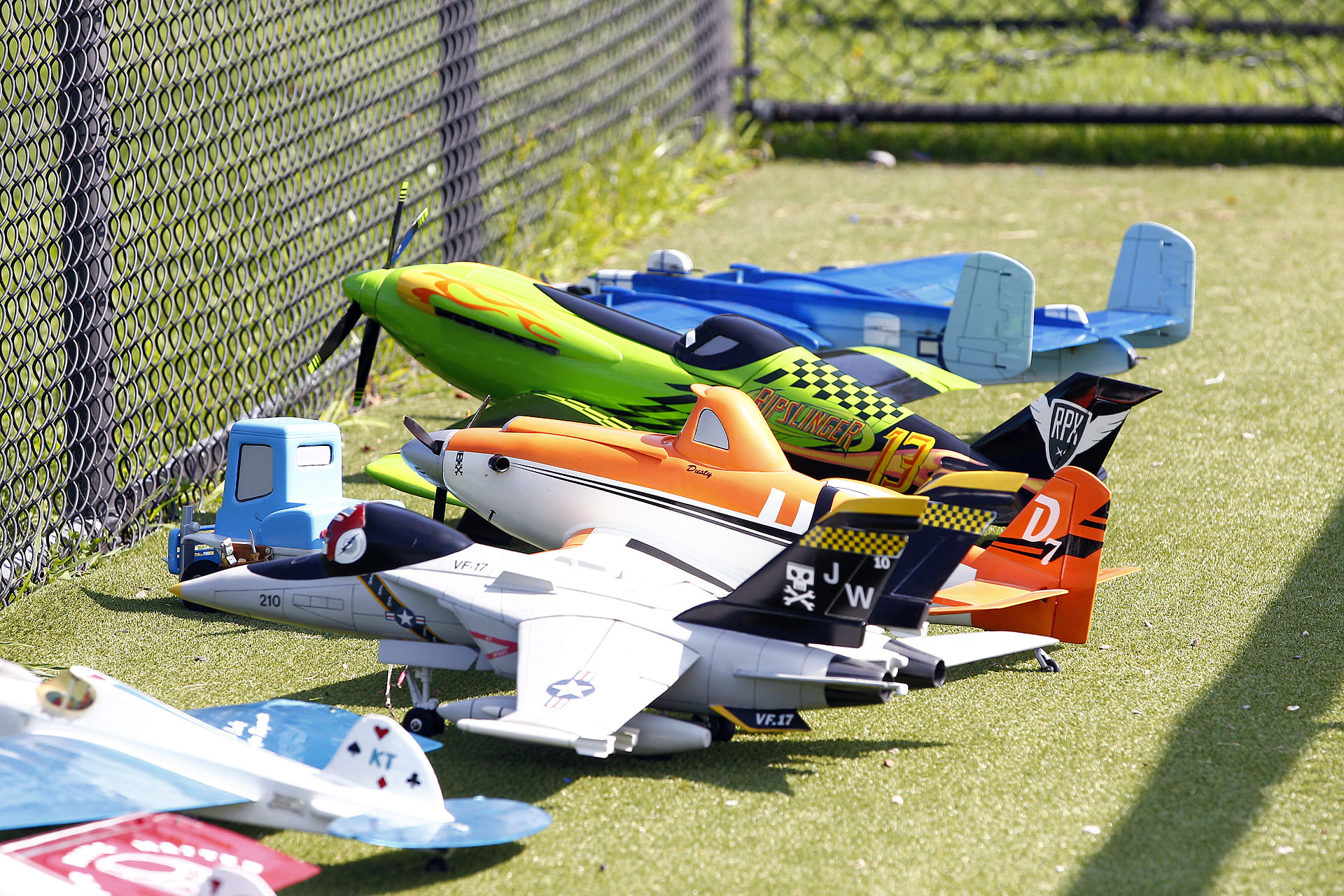
The Carl Hopkins WV Youth Aviation Expo stands as a testament to what can happen when a community rallies around its youth. We are already looking forward to next year’s edition.
2 MIN- Log in to post comments
MHIRJ AND THE CARL HOPKINS WV YOUTH AVIATION EXPO

TAKING FLIGHT AT THE CARL HOPKINS WV YOUTH AVIATION EXPO
If you’re looking for the perfect blend of excitement, learning, and community spirit, look no further than the Carl Hopkins WV Youth Aviation Expo. Named after the inspiring founder of West Virginia's first model aviation club in 1928, this annual event has become a beacon of opportunity and connection in Bridgeport, WV.
The 5th edition of the Expo, took place on August 8 and 9, at The Bridge Sports Complex, bringing together educators, aviation experts, local businesses, and community leaders, all united by a common goal: to ignite a passion for aviation in the hearts of young people.
A DAY OF HANDS-ON LEARNING
Participants were treated to a day packed with engaging activities. From building their very own model airplanes to experiencing control line and remote-control flights, there was something for everyone. Attendees were thrilled to watch live drone demonstrations and launch rockets, with all necessary supplies provided for them to take home.
Special attractions included fly-ins of Blackhawk helicopters and thrilling paramotor and parachute displays. College representatives and corporate sponsors connected aspiring aviators with future opportunities.

FAMILIES FLYING TOGETHER
What truly stood out at the Expo was the sense of community and bonding. For many families, this event wasn’t just a fun day out—it was an opportunity to create lasting memories together. Children and adults alike discovered new interests, learning collaboratively and cheering each other on. Whether it was assembling model airplanes or listening to stories from experienced pilots, the day served as a reminder that learning is a lifelong journey best shared.
Parents looked on with pride as their children unleashed their creativity, building rockets and exploring the world of aviation. The hands-on nature of the activities instilled a spirit of exploration and innovation in the hearts of the young participants.

The Carl Hopkins WV Youth Aviation Expo stands as a testament to what can happen when a community rallies around its youth. We are already looking forward to next year’s edition.
2 MIN- Log in to post comments
-
Welcome to Aéromart Montréal 2025!

Aéromart Montreal is a leading international business convention held every two years, bringing together professionals from the aerospace industry, including suppliers, manufacturers, and key decision-makers. Held in Montreal, a global hub for aerospace innovation, the event provides a platform for B2B meetings, panel discussions, and networking opportunities.

The Palais des Congrès de Montréal welcomed 800 companies and 1,400 participants representing 26 countries at the event. Over the course of three days, approximately 13,300 B2B meetings were held to foster innovation and collaboration in the aerospace sector.
MHIRJ was proud to be a vendor represented alongside Airbus, Pratt C Whitney Canada, and Bombardier, amongst many others.
Global Reach
Other events include Aéromart Toulouse—a similar convention in France, and various regional Aéromart events around the world. Each event is supported by the local community and organized by volunteers and industry professionals to support the cause.
“My first [event] was last December in Toulouse. But it is an absolute pleasure to be here in Montreal in our home base,” said Simon Sztrajt, Manager Procurement at MHIRJ. “We get to see suppliers we’re already working with who we want to continue to build our relationships with, and this is a place we can start some very important new relationships,” said Sztrajt.

Growth and Importance of the Aerospace Community
Aéromart Montreal began as a small event in 2008 to bring together aerospace professionals. Today, it has grown into a successful international convention built from the ground up with the help of its volunteers, partners, sponsors, and industry allies.

“It’s super important to have a show like Aéromart in Montreal because we’re the epicenter of aerospace in Canada. Actually, 70% of all aerospace RCD in Canada is takes place within the Greater Montreal Area,” said Mélanie Lussier, President of Aéro Montréal.
Turnout and Success
The day was filled with insightful discussions, networking, and success with an impressive turnout of people.
“41,700 people passionate about the aerospace industry work in the region. So, events like these are very important. We represent 230 companies from the smallest startup to the biggest OEM. We're very proud to host events like this in our region,” said Lussier.

Looking Ahead
Aéromart Montreal continues to serve the aerospace community and benefit its sponsors with the pride of knowing they are helping to advance an important industry. The next event, Aéromart Toulouse, will take place in France in 2026. For more information about Aéromart Montreal, please visit Aeromart Montréal 2025 - Home.
4 MIN.- Log in to post comments
Welcome to Aéromart Montréal 2025!

Aéromart Montreal is a leading international business convention held every two years, bringing together professionals from the aerospace industry, including suppliers, manufacturers, and key decision-makers. Held in Montreal, a global hub for aerospace innovation, the event provides a platform for B2B meetings, panel discussions, and networking opportunities.

The Palais des Congrès de Montréal welcomed 800 companies and 1,400 participants representing 26 countries at the event. Over the course of three days, approximately 13,300 B2B meetings were held to foster innovation and collaboration in the aerospace sector.
MHIRJ was proud to be a vendor represented alongside Airbus, Pratt C Whitney Canada, and Bombardier, amongst many others.
Global Reach
Other events include Aéromart Toulouse—a similar convention in France, and various regional Aéromart events around the world. Each event is supported by the local community and organized by volunteers and industry professionals to support the cause.
“My first [event] was last December in Toulouse. But it is an absolute pleasure to be here in Montreal in our home base,” said Simon Sztrajt, Manager Procurement at MHIRJ. “We get to see suppliers we’re already working with who we want to continue to build our relationships with, and this is a place we can start some very important new relationships,” said Sztrajt.

Growth and Importance of the Aerospace Community
Aéromart Montreal began as a small event in 2008 to bring together aerospace professionals. Today, it has grown into a successful international convention built from the ground up with the help of its volunteers, partners, sponsors, and industry allies.

“It’s super important to have a show like Aéromart in Montreal because we’re the epicenter of aerospace in Canada. Actually, 70% of all aerospace RCD in Canada is takes place within the Greater Montreal Area,” said Mélanie Lussier, President of Aéro Montréal.
Turnout and Success
The day was filled with insightful discussions, networking, and success with an impressive turnout of people.
“41,700 people passionate about the aerospace industry work in the region. So, events like these are very important. We represent 230 companies from the smallest startup to the biggest OEM. We're very proud to host events like this in our region,” said Lussier.

Looking Ahead
Aéromart Montreal continues to serve the aerospace community and benefit its sponsors with the pride of knowing they are helping to advance an important industry. The next event, Aéromart Toulouse, will take place in France in 2026. For more information about Aéromart Montreal, please visit Aeromart Montréal 2025 - Home.
4 MIN.- Log in to post comments
-
Carry the Culture: Building a High-Performance, Unified Team at MHIRJ

Culture serves as the foundation for all meaningful achievements. Our team recently took the opportunity during an All-Employee Conference call to celebrate the progress of our Carry the Culture initiative, a cornerstone of our midterm business plan that emphasizes the values and behaviors that define who we are as a company.
Together, across all our facilities, we are forging a high-performance, unified environment where everyone feels valued and engaged, paving the way for our shared success.
What Is Carry the Culture?
Carry the Culture is more than just a campaign; it’s a company-wide movement designed to embed our values into our everyday actions. As we say, “culture doesn’t happen by accident—it’s built with intent.”
Our values are the driving force behind how we operate and grow as a company. They inspire us to show up every day with purpose, collaborate effectively, and be accountable for our contributions toward our collective success. By actively incorporating these values into everything we do, we not only strengthen our internal culture but also set a benchmark for excellence in the industry.

Conversations That Drive Culture
We’ve engaged in meaningful dialogues with our leaders to ensure that our values are not just talked about but actively upheld.
Natalie Piccinin, Vice President of Human Resources, explained that these conversations are essential for fostering a culture that lives and breathes throughout the organization. Leaders are equipped with the tools to discuss our values with their teams, empowering everyone to embody these values and translate them into their roles effectively.
These discussions are not one-time events; they are part of a continuous journey to keep our culture evolving and relevant. Leaders will also bring these conversations into mid-year reviews, reinforcing the importance of our values in shaping our goals and daily actions.
The Symbolism Behind One Unified Team
A key visual element of our cultural initiative is the Enso circle, a powerful symbol rooted in Japanese tradition. Drawn as a single, continuous line, the Enso represents unity, yet its open end symbolizes our willingness to embrace new ideas and diverse voices. We view this openness as essential to our growth and innovation. Each bar along the Enso circle represents our individual team members, highlighting the unique contributions we all make while being part of one unified team.

Celebrating Our Culture in Action
We’re proud to witness how actively our values are being embraced across the organization. We showcased the Carry the Culture video, which captures the voices and experiences of employees who live these values every day. The video is a powerful reminder of the collective spirit we share and the dedication of our team members to uphold our values.
As part of the celebration, we’ve distributed Carry the Culture t-shirts at various locations, with more distributions scheduled.

Looking Forward: Building a Lasting Impact
Culture isn’t built overnight. It flourishes through continuous effort, intention, and the active participation of every team member. As we move forward, we’re deeply committed to sustaining the momentum of the Carry the Culture initiative. This includes ongoing discussions, celebrating successes, and ensuring that our behaviors align with the values we hold dear.
The Carry the Culture initiative is a testament to our commitment to a high-performance, unified team. It’s about more than just workplace behaviors; it’s about creating a workplace where everyone feels a sense of belonging, purpose, and pride in being part of MHIRJ.
3 MIN.- Log in to post comments
Carry the Culture: Building a High-Performance, Unified Team at MHIRJ

Culture serves as the foundation for all meaningful achievements. Our team recently took the opportunity during an All-Employee Conference call to celebrate the progress of our Carry the Culture initiative, a cornerstone of our midterm business plan that emphasizes the values and behaviors that define who we are as a company.
Together, across all our facilities, we are forging a high-performance, unified environment where everyone feels valued and engaged, paving the way for our shared success.
What Is Carry the Culture?
Carry the Culture is more than just a campaign; it’s a company-wide movement designed to embed our values into our everyday actions. As we say, “culture doesn’t happen by accident—it’s built with intent.”
Our values are the driving force behind how we operate and grow as a company. They inspire us to show up every day with purpose, collaborate effectively, and be accountable for our contributions toward our collective success. By actively incorporating these values into everything we do, we not only strengthen our internal culture but also set a benchmark for excellence in the industry.

Conversations That Drive Culture
We’ve engaged in meaningful dialogues with our leaders to ensure that our values are not just talked about but actively upheld.
Natalie Piccinin, Vice President of Human Resources, explained that these conversations are essential for fostering a culture that lives and breathes throughout the organization. Leaders are equipped with the tools to discuss our values with their teams, empowering everyone to embody these values and translate them into their roles effectively.
These discussions are not one-time events; they are part of a continuous journey to keep our culture evolving and relevant. Leaders will also bring these conversations into mid-year reviews, reinforcing the importance of our values in shaping our goals and daily actions.
The Symbolism Behind One Unified Team
A key visual element of our cultural initiative is the Enso circle, a powerful symbol rooted in Japanese tradition. Drawn as a single, continuous line, the Enso represents unity, yet its open end symbolizes our willingness to embrace new ideas and diverse voices. We view this openness as essential to our growth and innovation. Each bar along the Enso circle represents our individual team members, highlighting the unique contributions we all make while being part of one unified team.

Celebrating Our Culture in Action
We’re proud to witness how actively our values are being embraced across the organization. We showcased the Carry the Culture video, which captures the voices and experiences of employees who live these values every day. The video is a powerful reminder of the collective spirit we share and the dedication of our team members to uphold our values.
As part of the celebration, we’ve distributed Carry the Culture t-shirts at various locations, with more distributions scheduled.

Looking Forward: Building a Lasting Impact
Culture isn’t built overnight. It flourishes through continuous effort, intention, and the active participation of every team member. As we move forward, we’re deeply committed to sustaining the momentum of the Carry the Culture initiative. This includes ongoing discussions, celebrating successes, and ensuring that our behaviors align with the values we hold dear.
The Carry the Culture initiative is a testament to our commitment to a high-performance, unified team. It’s about more than just workplace behaviors; it’s about creating a workplace where everyone feels a sense of belonging, purpose, and pride in being part of MHIRJ.
3 MIN.- Log in to post comments
-
MHIRJ and Make-A-Wish: The 48-Hour Ride

At MHIRJ, we believe in the power of community, compassion, and making a difference. This September, we're proud to support the Make-A-Wish Foundation by participating in the annual 48 Hour-Ride, a cycling event that raises funds to grant the wishes of children with life-threatening medical conditions. It's a chance to bring hope, strength, and joy to these children and their families when they need it most.
The 48 Hour-Ride is more than just a cycling event—it's a marathon of goodwill, endurance, and community spirit. This year, the event will take place from September 20th to 22nd, where participants will ride in shifts, continuously cycling for 48 hours to raise money and awareness for the Make-A-Wish Foundation. This is not just a physical challenge, but a meaningful journey that connects everyone involved to a greater purpose.

MHIRJ has proudly supported this incredible cause since 2021. Our commitment to the community is an essential part of who we are, and events like this highlight our shared values.
This year, MHIRJ will be represented by two teams of six dedicated cyclists from across our Montreal sites. Our riders will brave all conditions, cycling in 1 or 2-hour shifts, day and night, rain or shine. Over the weekend, each cyclist will spend a total of nine hours on the bike, covering an average of 180 kilometers. But it’s not just about the distance—it’s about the journey and the impact we can have together.
For many of our riders, participating in the 48 Hour-Ride is deeply personal.
Steven Crofton, MHIRJ Technical Publications Manager, shared, “For me, it is a way to support a cause that has a direct impact on kids who are starting their lives fighting against the biggest struggles that one can face in a lifetime.” His dedication is a testament to the strength of our community and our shared commitment to making a difference.

The 48 Hour-Ride is also a powerful reminder of the privileges many of us may take for granted.
“As a parent myself, I am so grateful and blessed that my children have grown up healthy. Unfortunately, I have friends who had to live through the challenges, pain, and heartbreak of seeing one of their kids sick with a life-threatening disease,” he says. “No child and their families should have to go through such challenges in their lifetime.”
Beyond the physical challenge, the event fosters a sense of camaraderie and teamwork that extends beyond the ride.
“Every participant is proud of what they have accomplished, overcoming the physical challenges, riding day and night, and having collected funds that add up to a contribution of millions of dollars only on that specific 48-hour ride,” Crofton said.
“It builds camaraderie that continues beyond the event, building relationships and increasing the sense of belonging to the MHIRJ family. We are all proud to wear the MHIRJ colors, all for this common cause.”
We’re incredibly proud of our teams for their dedication, resilience, and the compassion they show on and off the bike. Together, we are stronger, and together, we can continue to bring hope and happiness to children in need. Go Team MHIRJ!
2 MIN.- Log in to post comments
MHIRJ and Make-A-Wish: The 48-Hour Ride

At MHIRJ, we believe in the power of community, compassion, and making a difference. This September, we're proud to support the Make-A-Wish Foundation by participating in the annual 48 Hour-Ride, a cycling event that raises funds to grant the wishes of children with life-threatening medical conditions. It's a chance to bring hope, strength, and joy to these children and their families when they need it most.
The 48 Hour-Ride is more than just a cycling event—it's a marathon of goodwill, endurance, and community spirit. This year, the event will take place from September 20th to 22nd, where participants will ride in shifts, continuously cycling for 48 hours to raise money and awareness for the Make-A-Wish Foundation. This is not just a physical challenge, but a meaningful journey that connects everyone involved to a greater purpose.

MHIRJ has proudly supported this incredible cause since 2021. Our commitment to the community is an essential part of who we are, and events like this highlight our shared values.
This year, MHIRJ will be represented by two teams of six dedicated cyclists from across our Montreal sites. Our riders will brave all conditions, cycling in 1 or 2-hour shifts, day and night, rain or shine. Over the weekend, each cyclist will spend a total of nine hours on the bike, covering an average of 180 kilometers. But it’s not just about the distance—it’s about the journey and the impact we can have together.
For many of our riders, participating in the 48 Hour-Ride is deeply personal.
Steven Crofton, MHIRJ Technical Publications Manager, shared, “For me, it is a way to support a cause that has a direct impact on kids who are starting their lives fighting against the biggest struggles that one can face in a lifetime.” His dedication is a testament to the strength of our community and our shared commitment to making a difference.

The 48 Hour-Ride is also a powerful reminder of the privileges many of us may take for granted.
“As a parent myself, I am so grateful and blessed that my children have grown up healthy. Unfortunately, I have friends who had to live through the challenges, pain, and heartbreak of seeing one of their kids sick with a life-threatening disease,” he says. “No child and their families should have to go through such challenges in their lifetime.”
Beyond the physical challenge, the event fosters a sense of camaraderie and teamwork that extends beyond the ride.
“Every participant is proud of what they have accomplished, overcoming the physical challenges, riding day and night, and having collected funds that add up to a contribution of millions of dollars only on that specific 48-hour ride,” Crofton said.
“It builds camaraderie that continues beyond the event, building relationships and increasing the sense of belonging to the MHIRJ family. We are all proud to wear the MHIRJ colors, all for this common cause.”
We’re incredibly proud of our teams for their dedication, resilience, and the compassion they show on and off the bike. Together, we are stronger, and together, we can continue to bring hope and happiness to children in need. Go Team MHIRJ!
2 MIN.- Log in to post comments
-
SO YOU WANT TO BE AN AVIATION TECHNICIAN?

Skilled aviation maintenance technicians are in high demand, so there's never been a better time to explore the opportunities. Whether you have a passion for aviation, a knack for technical expertise, or simply the curiosity and drive to learn, pursuing a hands-on career that offers a fast track to certification and long-term stability and growth could be in the cards for you.
A career as an FAA-certified aviation maintenance technician opens the door to a wide range of opportunities in the aviation industry, including working for a major MRO like MHIRJ. One of the most direct routes to a successful career in aviation maintenance is through an FAA-certified school.
THE PATH TO CERTIFICATION
On average, you can complete an FAA-certified aviation maintenance technician program in just 18-24 months. This intensive, full-time program equips students with the knowledge, skills, and practical education they need to get started. Upon successfully completing the program, graduates are then eligible to take the FAA exams to earn certification as an Airframe and Powerplant (A&P) mechanic. Having your A&P license gives you an advantage in terms of premiums, growth, and advancement in the industry, so it’s highly recommended that you obtain it.
To get started, look for aviation maintenance technician programs offered by community colleges, technical schools, or aviation maintenance training organizations. There are over 21,000 programs to choose from across the U.S. making the education easily accessible.
KICKSTARTING YOUR CAREER
Whether you're a recent high school graduate or looking to transition into a new field, the aviation industry welcomes individuals from all backgrounds to join its ranks of skilled professionals. While you don’t need any experience to begin your education and career, people with a military or other technical background often have an edge when pursuing a career in aviation maintenance. Their prior experience and expertise can accelerate their learning curve and provide them with a solid foundation for success in the field.
OPPORTUNITIES AND GROWTH
Many programs include internships or cooperative education opportunities where you can gain hands-on experience working on aircraft under the supervision of certified technicians. In fact, MHIRJ offers new graduates a paid mentorship program and a world of opportunities in aviation maintenance.
We hire graduates right out of school and offer a competitive salary that increases with experience and certifications. If you want a clear path for long-term career advancement and development, continuous training, full benefits, annual bonus, paid overtime, paid hourly premiums, and even a 7% match on your 401K, then MHIRJ is your gateway to success.
A GROWING WORKFORCE
Aviation is a high-demand industry with a rapidly increasing employment rate that’s 8% higher than the U.S. average, so embarking on a career as an FAA-certified aviation maintenance technician is not only rewarding but also offers the promise of solid earnings and career growth opportunities. With the right education, training, and determination, you can pave the way for a successful career in aviation maintenance. Make your move by exploring opportunities at MHIRJ: https://www.mhirj.com/en/careers3 MIN.- Log in to post comments
SO YOU WANT TO BE AN AVIATION TECHNICIAN?

Skilled aviation maintenance technicians are in high demand, so there's never been a better time to explore the opportunities. Whether you have a passion for aviation, a knack for technical expertise, or simply the curiosity and drive to learn, pursuing a hands-on career that offers a fast track to certification and long-term stability and growth could be in the cards for you.
A career as an FAA-certified aviation maintenance technician opens the door to a wide range of opportunities in the aviation industry, including working for a major MRO like MHIRJ. One of the most direct routes to a successful career in aviation maintenance is through an FAA-certified school.
THE PATH TO CERTIFICATION
On average, you can complete an FAA-certified aviation maintenance technician program in just 18-24 months. This intensive, full-time program equips students with the knowledge, skills, and practical education they need to get started. Upon successfully completing the program, graduates are then eligible to take the FAA exams to earn certification as an Airframe and Powerplant (A&P) mechanic. Having your A&P license gives you an advantage in terms of premiums, growth, and advancement in the industry, so it’s highly recommended that you obtain it.
To get started, look for aviation maintenance technician programs offered by community colleges, technical schools, or aviation maintenance training organizations. There are over 21,000 programs to choose from across the U.S. making the education easily accessible.
KICKSTARTING YOUR CAREER
Whether you're a recent high school graduate or looking to transition into a new field, the aviation industry welcomes individuals from all backgrounds to join its ranks of skilled professionals. While you don’t need any experience to begin your education and career, people with a military or other technical background often have an edge when pursuing a career in aviation maintenance. Their prior experience and expertise can accelerate their learning curve and provide them with a solid foundation for success in the field.
OPPORTUNITIES AND GROWTH
Many programs include internships or cooperative education opportunities where you can gain hands-on experience working on aircraft under the supervision of certified technicians. In fact, MHIRJ offers new graduates a paid mentorship program and a world of opportunities in aviation maintenance.
We hire graduates right out of school and offer a competitive salary that increases with experience and certifications. If you want a clear path for long-term career advancement and development, continuous training, full benefits, annual bonus, paid overtime, paid hourly premiums, and even a 7% match on your 401K, then MHIRJ is your gateway to success.
A GROWING WORKFORCE
Aviation is a high-demand industry with a rapidly increasing employment rate that’s 8% higher than the U.S. average, so embarking on a career as an FAA-certified aviation maintenance technician is not only rewarding but also offers the promise of solid earnings and career growth opportunities. With the right education, training, and determination, you can pave the way for a successful career in aviation maintenance. Make your move by exploring opportunities at MHIRJ: https://www.mhirj.com/en/careers3 MIN.- Log in to post comments
-
TRANSITIONING TO AVIATION MAINTENANCE

With the demand for skilled aviation maintenance technicians at an all-time high, it’s a great time to consider transitioning your career into a field that offers so much room for growth and advancement. While direct experience in aviation or mechanical fields is of course beneficial, there’s a diverse range of backgrounds, existing skills, and expertise that can provide you with a solid foundation and help set you up for a rewarding, long-term career.
A career in aviation maintenance could be closer than you think. In fact, having a background or skill set in a number of fields can give you the edge and help fast-track you toward success in the industry. We’ve compiled a list of examples of previous careers and skills that can be suitable for transitioning to become an aviation maintenance technician:
MILITARY PERSONNEL
Veterans, especially those with experience in any military aviation maintenance role, such as aircraft mechanics, technicians, or crew chiefs, possess valuable skills directly transferable to civilian aviation. Their training and hands-on experience with aircraft systems, maintenance procedures, and safety protocols provide a strong foundation for transitioning to civilian aviation maintenance roles.
MECHANICS AND TECHNICIANS
If you have experience in automotive or heavy equipment maintenance, you also bring relevant mechanical skills and valuable troubleshooting abilities to the aviation maintenance field. This kind of background means you’re familiar with tools, equipment, and diagnostic techniques that are also used in maintenance and repair tasks, making it easier to adapt to aircraft maintenance procedures.
ELECTRONICS AND ELECTRICAL ENGINEERING
Professionals with electronics and electrical engineering backgrounds have specialized knowledge in electrical systems, wiring, and electronic components. This expertise can be extremely valuable when it comes to troubleshooting and repairing avionics systems, like navigation, communication, and instrumentation systems, within various types of aircraft.
ENGINEERING AND TECHNICAL FIELDS
This one may seem evident, but if you have a degree or experience in engineering disciplines like aerospace or mechanics, you’re likely to have the analytical skills and technical knowledge applicable to aviation maintenance. This is especially true if you already specialize in aircraft structural analysis, propulsion systems, or avionics design, meaning you’ll bring rich expertise in aircraft systems and components.
SHEET METAL WORK
When it comes to structural repair and maintenance, sheet metal work experience is a huge asset. Skills like metalworking techniques, precision, and attention to detail are directly applicable to aircraft maintenance tasks like repairing damaged panels or fabricating replacement parts. As a bonus, familiarity with blueprints and technical drawings, a safety-conscious mindset, and possessing problem-solving abilities are always welcome.
QUALITY ASSURANCE AND INSPECTION
If you have any background or experience in quality assurance, inspection, or regulatory compliance roles, then you’re likely to have a strong understanding of industry standards, regulations, and safety protocols, which is, of course, inherently essential in aviation. Your attention to detail, adherence to procedures, and ability to ensure compliance with regulatory requirements are extremely valuable assets in aviation maintenance, particularly in roles involving inspection, quality control, or certification.
TECHNICAL TRAINING AND EDUCATION
People with experience as technical trainers, educators, or instructors bring skills in curriculum development, training delivery, and student assessment to the aviation maintenance field. They can contribute to developing and delivering aviation maintenance training programs, ensuring that technicians receive comprehensive and effective training.
PROBLEM-SOLVING AND CRITICAL-THINKING SKILLS
Regardless of your previous career background, if you possess strong problem-solving, critical thinking, and troubleshooting skills, then you’re well-suited for aviation maintenance roles. These skills enable technicians to diagnose issues, develop effective solutions, and perform maintenance tasks efficiently and safely.
While these backgrounds and skills can facilitate the transition to becoming an aviation maintenance technician, there may be additional training, education, or certification needed to meet some specific requirements of the aviation industry. But by leveraging your existing experience and skills, you can look forward to a successful career path in aviation maintenance. If you’re ready to make your move, then start exploring the many current opportunities at MHIRJ: https://www.mhirj.com/en/careers3 MIN.- Log in to post comments
TRANSITIONING TO AVIATION MAINTENANCE

With the demand for skilled aviation maintenance technicians at an all-time high, it’s a great time to consider transitioning your career into a field that offers so much room for growth and advancement. While direct experience in aviation or mechanical fields is of course beneficial, there’s a diverse range of backgrounds, existing skills, and expertise that can provide you with a solid foundation and help set you up for a rewarding, long-term career.
A career in aviation maintenance could be closer than you think. In fact, having a background or skill set in a number of fields can give you the edge and help fast-track you toward success in the industry. We’ve compiled a list of examples of previous careers and skills that can be suitable for transitioning to become an aviation maintenance technician:
MILITARY PERSONNEL
Veterans, especially those with experience in any military aviation maintenance role, such as aircraft mechanics, technicians, or crew chiefs, possess valuable skills directly transferable to civilian aviation. Their training and hands-on experience with aircraft systems, maintenance procedures, and safety protocols provide a strong foundation for transitioning to civilian aviation maintenance roles.
MECHANICS AND TECHNICIANS
If you have experience in automotive or heavy equipment maintenance, you also bring relevant mechanical skills and valuable troubleshooting abilities to the aviation maintenance field. This kind of background means you’re familiar with tools, equipment, and diagnostic techniques that are also used in maintenance and repair tasks, making it easier to adapt to aircraft maintenance procedures.
ELECTRONICS AND ELECTRICAL ENGINEERING
Professionals with electronics and electrical engineering backgrounds have specialized knowledge in electrical systems, wiring, and electronic components. This expertise can be extremely valuable when it comes to troubleshooting and repairing avionics systems, like navigation, communication, and instrumentation systems, within various types of aircraft.
ENGINEERING AND TECHNICAL FIELDS
This one may seem evident, but if you have a degree or experience in engineering disciplines like aerospace or mechanics, you’re likely to have the analytical skills and technical knowledge applicable to aviation maintenance. This is especially true if you already specialize in aircraft structural analysis, propulsion systems, or avionics design, meaning you’ll bring rich expertise in aircraft systems and components.
SHEET METAL WORK
When it comes to structural repair and maintenance, sheet metal work experience is a huge asset. Skills like metalworking techniques, precision, and attention to detail are directly applicable to aircraft maintenance tasks like repairing damaged panels or fabricating replacement parts. As a bonus, familiarity with blueprints and technical drawings, a safety-conscious mindset, and possessing problem-solving abilities are always welcome.
QUALITY ASSURANCE AND INSPECTION
If you have any background or experience in quality assurance, inspection, or regulatory compliance roles, then you’re likely to have a strong understanding of industry standards, regulations, and safety protocols, which is, of course, inherently essential in aviation. Your attention to detail, adherence to procedures, and ability to ensure compliance with regulatory requirements are extremely valuable assets in aviation maintenance, particularly in roles involving inspection, quality control, or certification.
TECHNICAL TRAINING AND EDUCATION
People with experience as technical trainers, educators, or instructors bring skills in curriculum development, training delivery, and student assessment to the aviation maintenance field. They can contribute to developing and delivering aviation maintenance training programs, ensuring that technicians receive comprehensive and effective training.
PROBLEM-SOLVING AND CRITICAL-THINKING SKILLS
Regardless of your previous career background, if you possess strong problem-solving, critical thinking, and troubleshooting skills, then you’re well-suited for aviation maintenance roles. These skills enable technicians to diagnose issues, develop effective solutions, and perform maintenance tasks efficiently and safely.
While these backgrounds and skills can facilitate the transition to becoming an aviation maintenance technician, there may be additional training, education, or certification needed to meet some specific requirements of the aviation industry. But by leveraging your existing experience and skills, you can look forward to a successful career path in aviation maintenance. If you’re ready to make your move, then start exploring the many current opportunities at MHIRJ: https://www.mhirj.com/en/careers3 MIN.- Log in to post comments
-
NEW CAREERS ARE TAKING FLIGHT AT MHIRJ

As the industry need for skilled aviation technicians continues to grow, MHIRJ is being proactive and seizing the opportunity to invest in talent development by introducing the new MHIRJ Academy.
What better way to grow our team than to provide immersive in-house education? Through the MHIRJ Academy, we’ll be providing paid training to build a new generation of highly skilled structural technicians, creating a talent pipeline to counter the current low numbers of skilled sheet metal technicians in the labor workforce.
ADRESSING THE SKILLS GAP
The strategic decision to launch the Academy not only ensures a steady supply of skilled workers, but also fosters a sense of camaraderie and community among our employees. The Academy will train approximately 5 groups of 20 students, with the goal of training at least 100 new structural technicians at our Bridgeport, West Virginia Service Center by May 2025. This initiative not only addresses the immediate need for skilled workers but also lays the foundation for a sustainable workforce in the long term.
THE PROGRAM AT A GLANCE
The MHIRJ Academy training program has been meticulously designed to equip students with the necessary skills to become structures technicians who will eventually work on airframe and structural repairs on aircraft. New recruits are welcomed from the local community of Harrison and Marion Counties, fostering local economic growth and securing high-paying, long-term career opportunities in aviation for those who qualify.
The training program consists of an 8-week curriculum, during which students are fully paid. Following this initial training period, students transition into apprenticeships until they obtain a repairman's certificate, a process that typically takes around two months. Leveraging the expertise of seasoned instructors with extensive repair experience, the MHIRJ Academy ensures that students receive top-notch training tailored to our customer’s specific needs.
“I feel fortunate to be brought in on this project from the ground up,” said Kenny Sinclair, Lead Instructor, MHIRJ Structures Technician Training Program. “I hope that I will teach someone something new that they will then pass down to someone else in the future. I'm looking forward to seeing the students use their new skills and develop them into a career in which there are many different opportunities to advance.”A FULFILLING FUTURE IN AVIATION
Beyond being financially compensated for their 8 weeks of training, graduates of the Academy can look forward to fulfilling long-term employment with MHIRJ, and the opportunity to continue earning further certifications should they wish to do so.We’re proud of our workforce and our community, and are excited to welcome hundreds of new members to our ever-growing team. In launching the MHIRJ Academy, we remain committed to investing in talent development and fostering a sustainable workforce in the communities where we operate. This helps ensure our own continued success, as well as contributing to the vitality and growth of the aerospace sector as a whole. As the first cohort of students embarks on their journey to earn their wings with us, they represent not just the future of MHIRJ but the future of aerospace innovation and excellence.
Interested in pursuing a new career path in aviation? Learn more about the Academy and explore current employment opportunities with us.3 MIN.- Log in to post comments
NEW CAREERS ARE TAKING FLIGHT AT MHIRJ

As the industry need for skilled aviation technicians continues to grow, MHIRJ is being proactive and seizing the opportunity to invest in talent development by introducing the new MHIRJ Academy.
What better way to grow our team than to provide immersive in-house education? Through the MHIRJ Academy, we’ll be providing paid training to build a new generation of highly skilled structural technicians, creating a talent pipeline to counter the current low numbers of skilled sheet metal technicians in the labor workforce.
ADRESSING THE SKILLS GAP
The strategic decision to launch the Academy not only ensures a steady supply of skilled workers, but also fosters a sense of camaraderie and community among our employees. The Academy will train approximately 5 groups of 20 students, with the goal of training at least 100 new structural technicians at our Bridgeport, West Virginia Service Center by May 2025. This initiative not only addresses the immediate need for skilled workers but also lays the foundation for a sustainable workforce in the long term.
THE PROGRAM AT A GLANCE
The MHIRJ Academy training program has been meticulously designed to equip students with the necessary skills to become structures technicians who will eventually work on airframe and structural repairs on aircraft. New recruits are welcomed from the local community of Harrison and Marion Counties, fostering local economic growth and securing high-paying, long-term career opportunities in aviation for those who qualify.
The training program consists of an 8-week curriculum, during which students are fully paid. Following this initial training period, students transition into apprenticeships until they obtain a repairman's certificate, a process that typically takes around two months. Leveraging the expertise of seasoned instructors with extensive repair experience, the MHIRJ Academy ensures that students receive top-notch training tailored to our customer’s specific needs.
“I feel fortunate to be brought in on this project from the ground up,” said Kenny Sinclair, Lead Instructor, MHIRJ Structures Technician Training Program. “I hope that I will teach someone something new that they will then pass down to someone else in the future. I'm looking forward to seeing the students use their new skills and develop them into a career in which there are many different opportunities to advance.”A FULFILLING FUTURE IN AVIATION
Beyond being financially compensated for their 8 weeks of training, graduates of the Academy can look forward to fulfilling long-term employment with MHIRJ, and the opportunity to continue earning further certifications should they wish to do so.We’re proud of our workforce and our community, and are excited to welcome hundreds of new members to our ever-growing team. In launching the MHIRJ Academy, we remain committed to investing in talent development and fostering a sustainable workforce in the communities where we operate. This helps ensure our own continued success, as well as contributing to the vitality and growth of the aerospace sector as a whole. As the first cohort of students embarks on their journey to earn their wings with us, they represent not just the future of MHIRJ but the future of aerospace innovation and excellence.
Interested in pursuing a new career path in aviation? Learn more about the Academy and explore current employment opportunities with us.3 MIN.- Log in to post comments
-
AMT: EMPLOYMENT ON THE RISE

We recently began exploring the ever-rising demand for qualified aviation technicians that has been impacting our industry. With air travel seeing record numbers, we’re also seeing major shifts in key statistics around employment opportunities with airports, MROS, and OEMs. Today, we’re taking a closer look at the numbers and what they mean for those looking for long-term career in a field that’s showing no signs of slowing down.
While some industries have experienced mass layoffs, aviation and travel are back to pre-pandemic levels and growing. “Labour shortage in the aviation industry translates into parked aircraft and cancelled flights. Aviation relies on skilled aircraft technicians to keep aircraft flying and communities connected across the United States. We want to be part of the solution for the industry” says Ross Mitchell, Vice President, Strategy and Business Development at MHIRJ.
Before we dig a little deeper into the numbers, let’s recap what we already know based on recent reports.
Projections show that until 2030 there will be an estimated employment growth rate of 12% for mechanics and service technicians, and 10% for avionics technicians. This employment growth rate is actually projected to be 8% higher than the rest of the U.S. job market, meaning it opens the doors to new graduates who want a lasting career with plenty of opportunity, and is great news for experienced technicians who wish to continue advancing in the industry.
And although we’ve seen increased interest, an uptick of 2.2% in Aircraft Maintenance Technician School (AMTS) graduates, and 7,119 new mechanic certificates issued by the FAA last year, there will still be an average of 12,800 job openings per year until 2032 to make up for the 21% annual increase needed to support the commercial market. These numbers show that we still have a way to go to meet the demand as numbers continue to fall short of the pre-pandemic rates.
TAPPING INTO EQUAL AND AMPLE OPPORTUNITY
The aviation industry has long been known for being male-dominant. In fact, only 2.7% of aircraft mechanics are women, but this number has also started skewing higher. Women have equal opportunity in the field, so it’s important to support inclusivity and demonstrate that this is a solid career path for anyone who wishes to pursue it. In fact, an average of 48% of AMT students receive a job offer immediately upon graduation. This shows once again that the industry is powering ahead and job opportunities are abundant.
On the flip side, we also know that 40% of current aviation technicians could retire by 2030, and there is a vacancy rate of 27% for aircraft maintenance workers projected by 2027. This means that there is ample space for an entirely new generation to step in and be the future of the industry. And with options to fast-track education, get paid during training, and get hired immediately, there’s never been a better time to get started and to fill one of the 12,800 AMT job openings that are available each year.
A GROWING WORKFORCE
When we look at the big picture, we can see that 48,000 new technicians can join the workforce by 2027, making it clearly worthwhile to pursue education, start training, or transfer your skills. Be part of the industry that’s on the up.
“We need solutions like the Aviation WORKS Act to help fund training for maintenance technicians and make it more accessible for the next generation to kick start their careers in aviation,” Ross Mitchell says.
Stay tuned to WINGSPAN for more on the education and hiring process. Ready to make your move? Explore the current job openings at MHIRJ: https://mhirj.com/en/careers2 MIN.- Log in to post comments
AMT: EMPLOYMENT ON THE RISE

We recently began exploring the ever-rising demand for qualified aviation technicians that has been impacting our industry. With air travel seeing record numbers, we’re also seeing major shifts in key statistics around employment opportunities with airports, MROS, and OEMs. Today, we’re taking a closer look at the numbers and what they mean for those looking for long-term career in a field that’s showing no signs of slowing down.
While some industries have experienced mass layoffs, aviation and travel are back to pre-pandemic levels and growing. “Labour shortage in the aviation industry translates into parked aircraft and cancelled flights. Aviation relies on skilled aircraft technicians to keep aircraft flying and communities connected across the United States. We want to be part of the solution for the industry” says Ross Mitchell, Vice President, Strategy and Business Development at MHIRJ.
Before we dig a little deeper into the numbers, let’s recap what we already know based on recent reports.
Projections show that until 2030 there will be an estimated employment growth rate of 12% for mechanics and service technicians, and 10% for avionics technicians. This employment growth rate is actually projected to be 8% higher than the rest of the U.S. job market, meaning it opens the doors to new graduates who want a lasting career with plenty of opportunity, and is great news for experienced technicians who wish to continue advancing in the industry.
And although we’ve seen increased interest, an uptick of 2.2% in Aircraft Maintenance Technician School (AMTS) graduates, and 7,119 new mechanic certificates issued by the FAA last year, there will still be an average of 12,800 job openings per year until 2032 to make up for the 21% annual increase needed to support the commercial market. These numbers show that we still have a way to go to meet the demand as numbers continue to fall short of the pre-pandemic rates.
TAPPING INTO EQUAL AND AMPLE OPPORTUNITY
The aviation industry has long been known for being male-dominant. In fact, only 2.7% of aircraft mechanics are women, but this number has also started skewing higher. Women have equal opportunity in the field, so it’s important to support inclusivity and demonstrate that this is a solid career path for anyone who wishes to pursue it. In fact, an average of 48% of AMT students receive a job offer immediately upon graduation. This shows once again that the industry is powering ahead and job opportunities are abundant.
On the flip side, we also know that 40% of current aviation technicians could retire by 2030, and there is a vacancy rate of 27% for aircraft maintenance workers projected by 2027. This means that there is ample space for an entirely new generation to step in and be the future of the industry. And with options to fast-track education, get paid during training, and get hired immediately, there’s never been a better time to get started and to fill one of the 12,800 AMT job openings that are available each year.
A GROWING WORKFORCE
When we look at the big picture, we can see that 48,000 new technicians can join the workforce by 2027, making it clearly worthwhile to pursue education, start training, or transfer your skills. Be part of the industry that’s on the up.
“We need solutions like the Aviation WORKS Act to help fund training for maintenance technicians and make it more accessible for the next generation to kick start their careers in aviation,” Ross Mitchell says.
Stay tuned to WINGSPAN for more on the education and hiring process. Ready to make your move? Explore the current job openings at MHIRJ: https://mhirj.com/en/careers2 MIN.- Log in to post comments
-
A WORLD OF OPPORTUNITY FOR AVIATION TECHNICIANS

Recent years have seen major shifts in the airline industry, and most recently, we’re seeing record numbers on the horizon. With increased airline service comes an increased demand for qualified aviation maintenance technicians to support the industry. This opens the doors to a world of opportunity for those looking to start their career or make a fulfilling career move.
At a time when other industries are experiencing fluctuations in the job market, employment in the aerospace industry is skyrocketing. More specifically, recent data shows that there’s a rapidly growing demand for aircraft maintenance technicians. In the coming weeks, we’ll explore the projections, present the opportunities, and break down the steps for those interested in pursuing an aviation maintenance career. But first, let’s take a look at some of the numbers.
IT'S ALL IN THE DATA
Starting with the big picture, it’s projected that until 2030 there will be a steady employment growth rate of 12% for mechanics and service technicians, and 10% for avionics technicians. This is great news for both new graduates looking to solidify a long-term career with plenty of opportunity for advancement, and seasoned technicians whose wealth of skills have lasting value. In fact, this employment growth rate is outpacing the rest of the U.S. job market by 8%, making this industry truly one to watch.
AMPLE ACCESS TO EDUCATION
Although we’ve seen a 2.2% increase in graduates, displaying increased interest, Aircraft Maintenance Technician School (AMTS) have abundant availability for student enrollment across the country. Pursuing this kind of education offers students a pathway to a rewarding and in-demand career in the aviation industry which projects an average of 12,800 job openings per year until 2032. With different pathways to certification, transferrable skills from other industries, and mentorship and training opportunities, there are plenty of viable options for people from all backgrounds to build a solid professional foundation in the industry.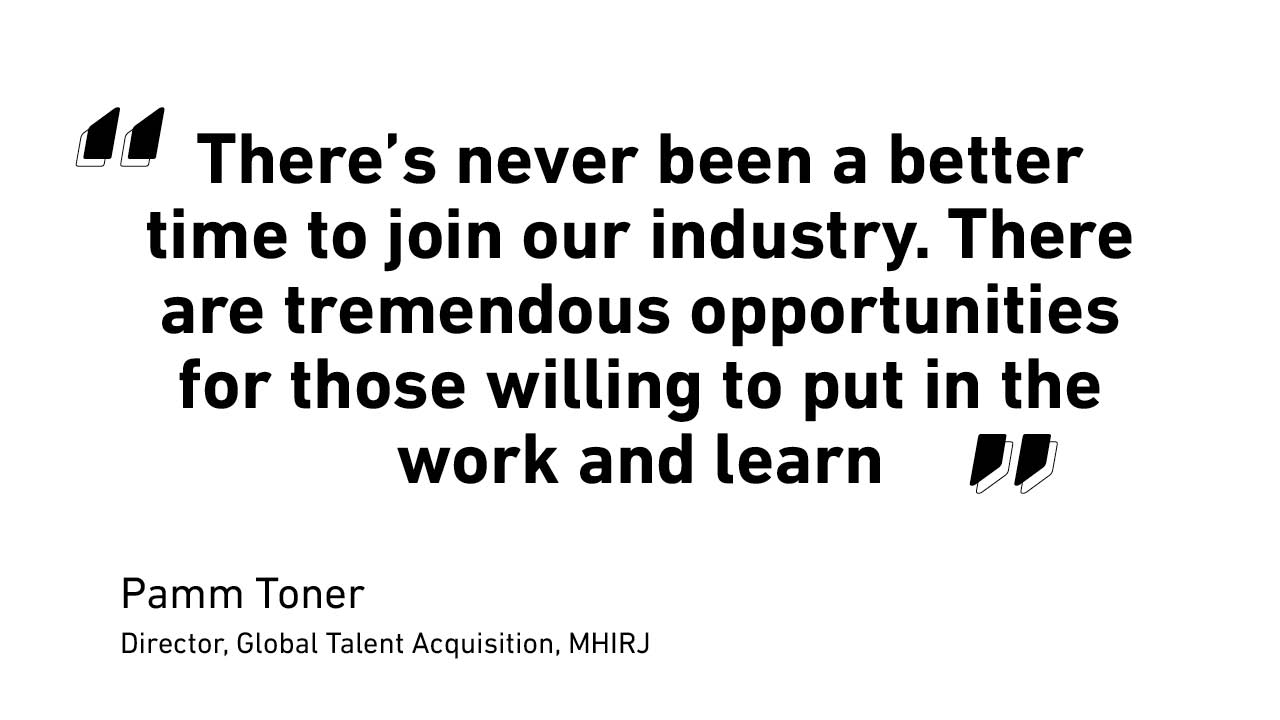
“Our people and our commitment to each other sets us apart. We expose future technicians to a variety of tasks and challenges. Teaching and coaching the next generation of AMTs is part of our DNA.”
With growing demand, technological advancements, and abundant career opportunities, now is an opportune time to pursue training and education in aircraft maintenance. Get started by exploring the current job openings at MHIRJ: https://mhirj.com/en/careers2 MIN.- Log in to post comments
A WORLD OF OPPORTUNITY FOR AVIATION TECHNICIANS

Recent years have seen major shifts in the airline industry, and most recently, we’re seeing record numbers on the horizon. With increased airline service comes an increased demand for qualified aviation maintenance technicians to support the industry. This opens the doors to a world of opportunity for those looking to start their career or make a fulfilling career move.
At a time when other industries are experiencing fluctuations in the job market, employment in the aerospace industry is skyrocketing. More specifically, recent data shows that there’s a rapidly growing demand for aircraft maintenance technicians. In the coming weeks, we’ll explore the projections, present the opportunities, and break down the steps for those interested in pursuing an aviation maintenance career. But first, let’s take a look at some of the numbers.
IT'S ALL IN THE DATA
Starting with the big picture, it’s projected that until 2030 there will be a steady employment growth rate of 12% for mechanics and service technicians, and 10% for avionics technicians. This is great news for both new graduates looking to solidify a long-term career with plenty of opportunity for advancement, and seasoned technicians whose wealth of skills have lasting value. In fact, this employment growth rate is outpacing the rest of the U.S. job market by 8%, making this industry truly one to watch.
AMPLE ACCESS TO EDUCATION
Although we’ve seen a 2.2% increase in graduates, displaying increased interest, Aircraft Maintenance Technician School (AMTS) have abundant availability for student enrollment across the country. Pursuing this kind of education offers students a pathway to a rewarding and in-demand career in the aviation industry which projects an average of 12,800 job openings per year until 2032. With different pathways to certification, transferrable skills from other industries, and mentorship and training opportunities, there are plenty of viable options for people from all backgrounds to build a solid professional foundation in the industry.
“Our people and our commitment to each other sets us apart. We expose future technicians to a variety of tasks and challenges. Teaching and coaching the next generation of AMTs is part of our DNA.”
With growing demand, technological advancements, and abundant career opportunities, now is an opportune time to pursue training and education in aircraft maintenance. Get started by exploring the current job openings at MHIRJ: https://mhirj.com/en/careers2 MIN.- Log in to post comments
-
Unveiling the new MHIRJ Flight Deck app

Becoming a safer and better informed CRJ pilot is now just a tap away. With the creation of the new MHIRJ Flight Deck app, pilots can access critical flight information with the touch of a finger.
This newly-introduced app eliminates the need for pilots to carry heavy and cumbersome operating manuals, navigation charts, reference handbooks, flight checklists, logbooks, and weather information in their flight bag. Instead, they can access all necessary documents using a single iPad®, which weighs less than 1.5 pounds.
With the MHIRJ Flight Deck app, CRJ pilots can enjoy the benefits of going paperless by instantly storing and accessing manual data and other documentation from their iPad® - without Wi-Fi.
Improving on existing apps, it empowers pilots to efficiently manage documents using tags, color codes, and favorites, ensuring faster access. New features such as one-touch full-screen mode and thumbnail page view make reading PDF files swift and intuitive. Documents can be easily annotated using ink, highlighter, text, notes, and various other tools. All of which reduces pilot workload and increases safety.
The app that does it all
No other solution combines automatic temporary revision updates, content user control, and aircraft serial number-specific information into one application. The new app also generates FAA, EASA, and TC-compliant audit trails for paperless¹ operations to ensure flight manuals are current. Time is saved, and pilots are always ready to fly per the latest regulatory requirements. In addition, fleet managers, dispatchers, and other members of your team can drag and drop electronic versions of aircraft documents, manuals, and forms into online folders, allowing pilots to control all their electronic documentation in one place.
Find out more on how we’ve made going paperless in the cockpit, painless.
For subscription, pricing, and availability of the CRJ flight manuals on the MHIRJ Flight Deck application, contact sales.techpubs@mhirj.com or call 437-800 3366.
For technical assistance with the MHIRJ Flight Deck application, please reach out to support@obds.com or call +1 (450) 476-1420.2 MIN.- Log in to post comments
Unveiling the new MHIRJ Flight Deck app

Becoming a safer and better informed CRJ pilot is now just a tap away. With the creation of the new MHIRJ Flight Deck app, pilots can access critical flight information with the touch of a finger.
This newly-introduced app eliminates the need for pilots to carry heavy and cumbersome operating manuals, navigation charts, reference handbooks, flight checklists, logbooks, and weather information in their flight bag. Instead, they can access all necessary documents using a single iPad®, which weighs less than 1.5 pounds.
With the MHIRJ Flight Deck app, CRJ pilots can enjoy the benefits of going paperless by instantly storing and accessing manual data and other documentation from their iPad® - without Wi-Fi.
Improving on existing apps, it empowers pilots to efficiently manage documents using tags, color codes, and favorites, ensuring faster access. New features such as one-touch full-screen mode and thumbnail page view make reading PDF files swift and intuitive. Documents can be easily annotated using ink, highlighter, text, notes, and various other tools. All of which reduces pilot workload and increases safety.
The app that does it all
No other solution combines automatic temporary revision updates, content user control, and aircraft serial number-specific information into one application. The new app also generates FAA, EASA, and TC-compliant audit trails for paperless¹ operations to ensure flight manuals are current. Time is saved, and pilots are always ready to fly per the latest regulatory requirements. In addition, fleet managers, dispatchers, and other members of your team can drag and drop electronic versions of aircraft documents, manuals, and forms into online folders, allowing pilots to control all their electronic documentation in one place.
Find out more on how we’ve made going paperless in the cockpit, painless.
For subscription, pricing, and availability of the CRJ flight manuals on the MHIRJ Flight Deck application, contact sales.techpubs@mhirj.com or call 437-800 3366.
For technical assistance with the MHIRJ Flight Deck application, please reach out to support@obds.com or call +1 (450) 476-1420.2 MIN.- Log in to post comments

 24
24

